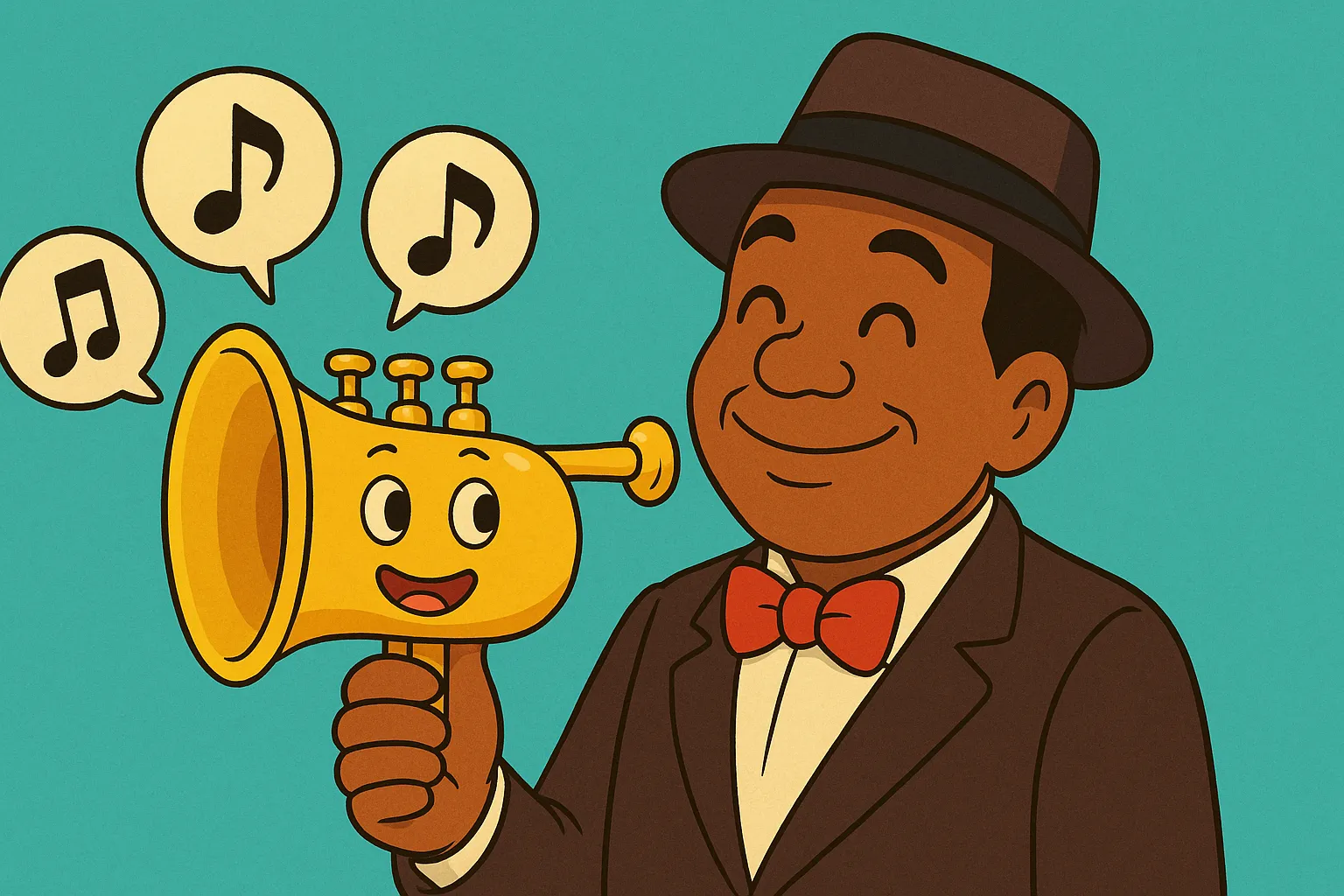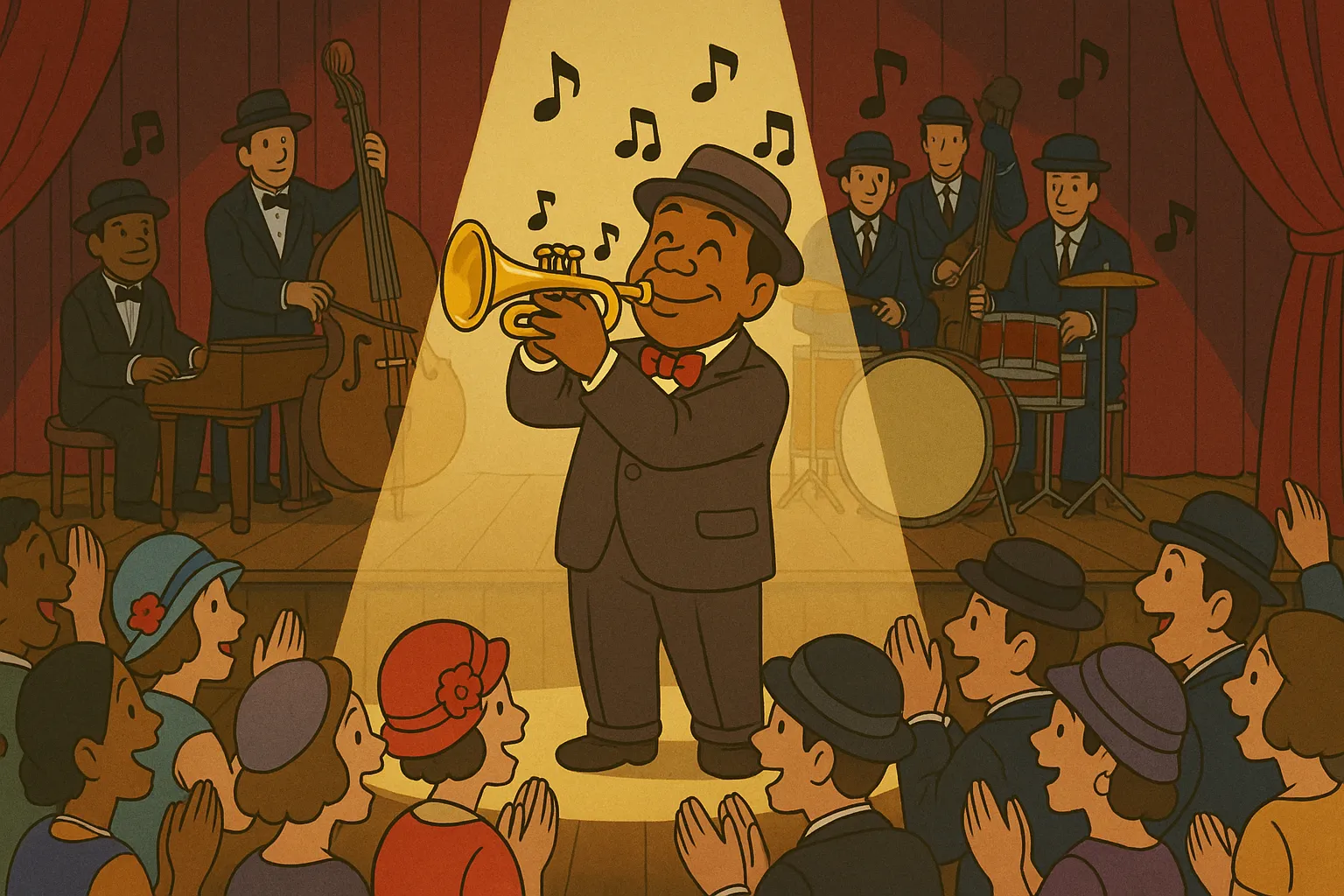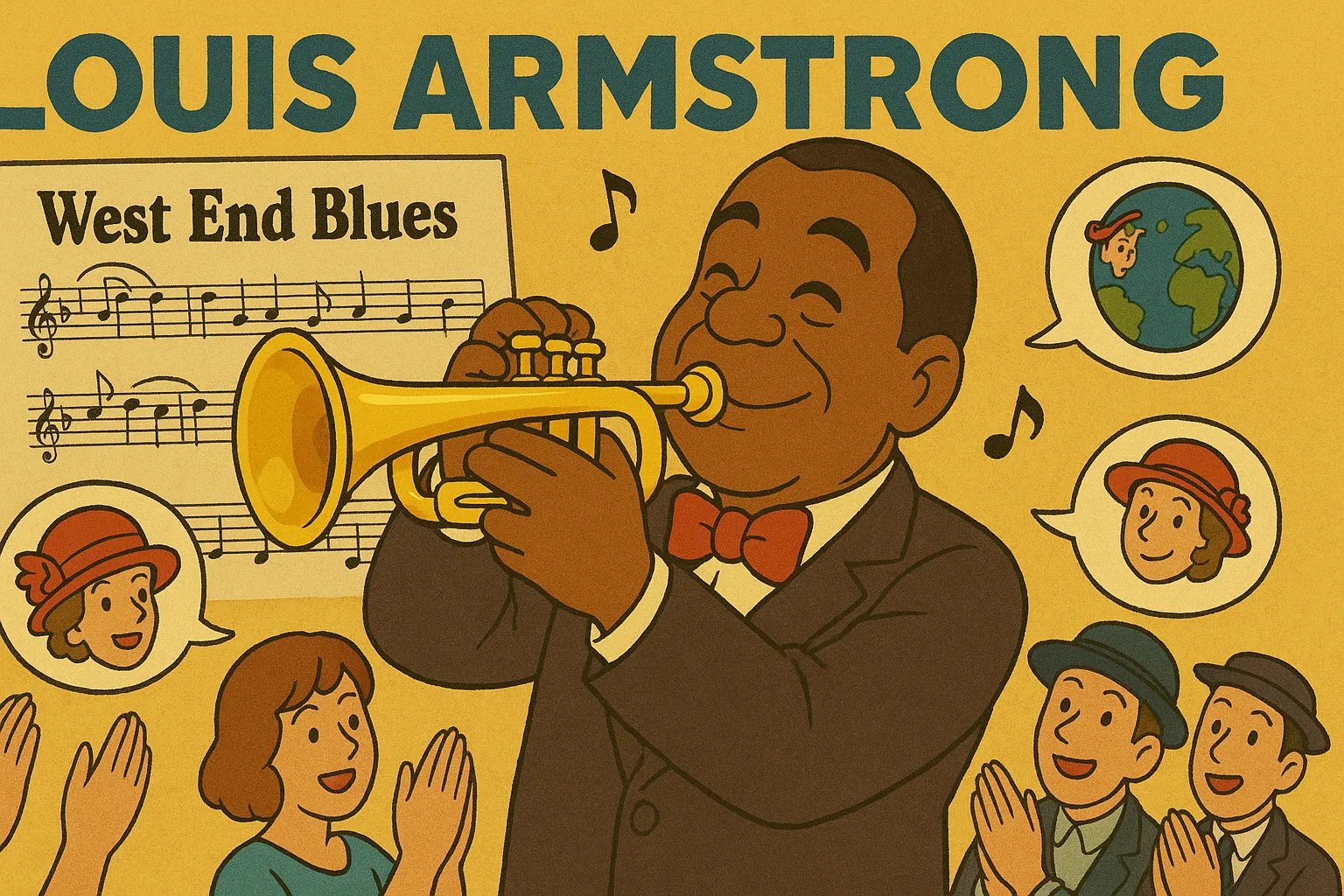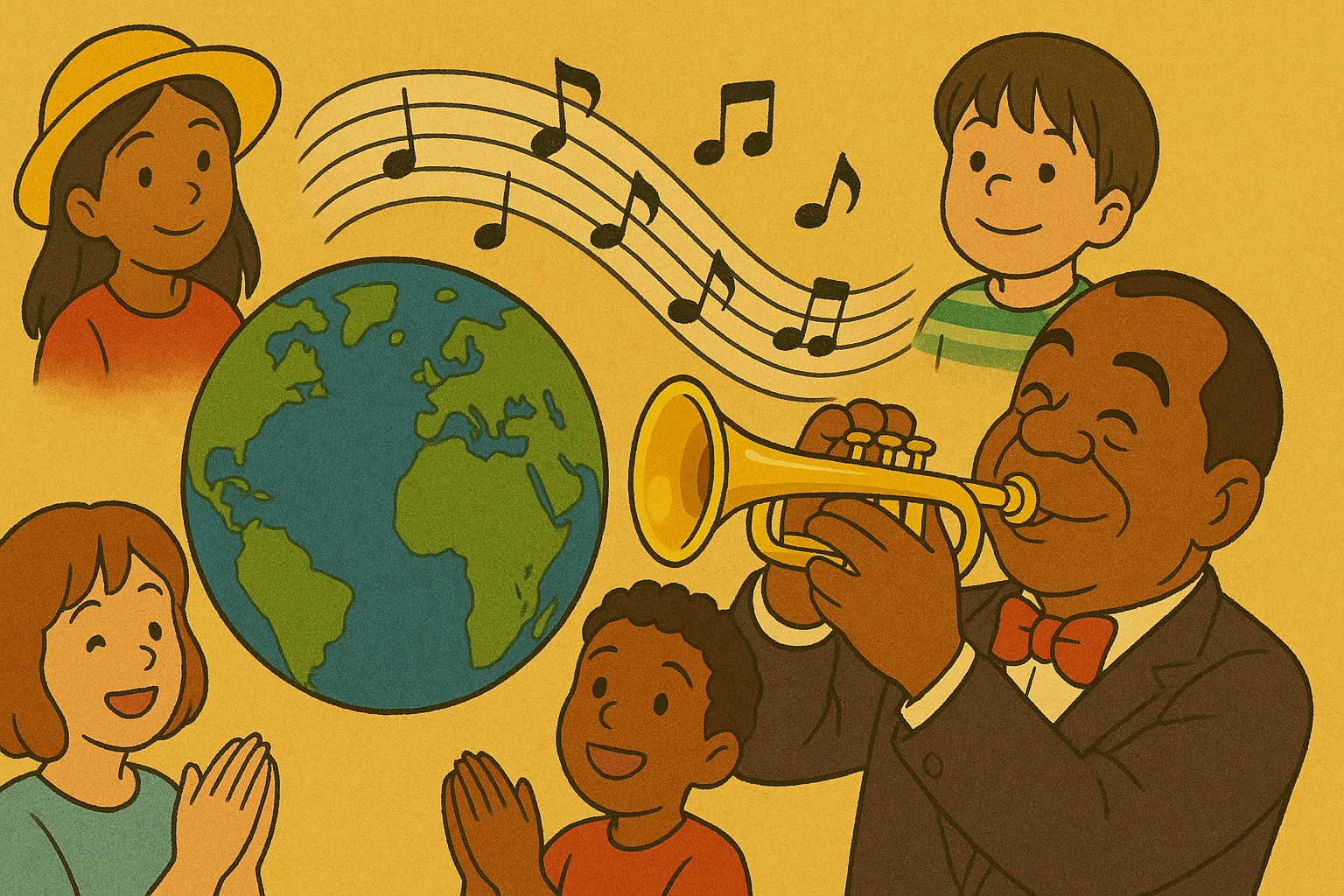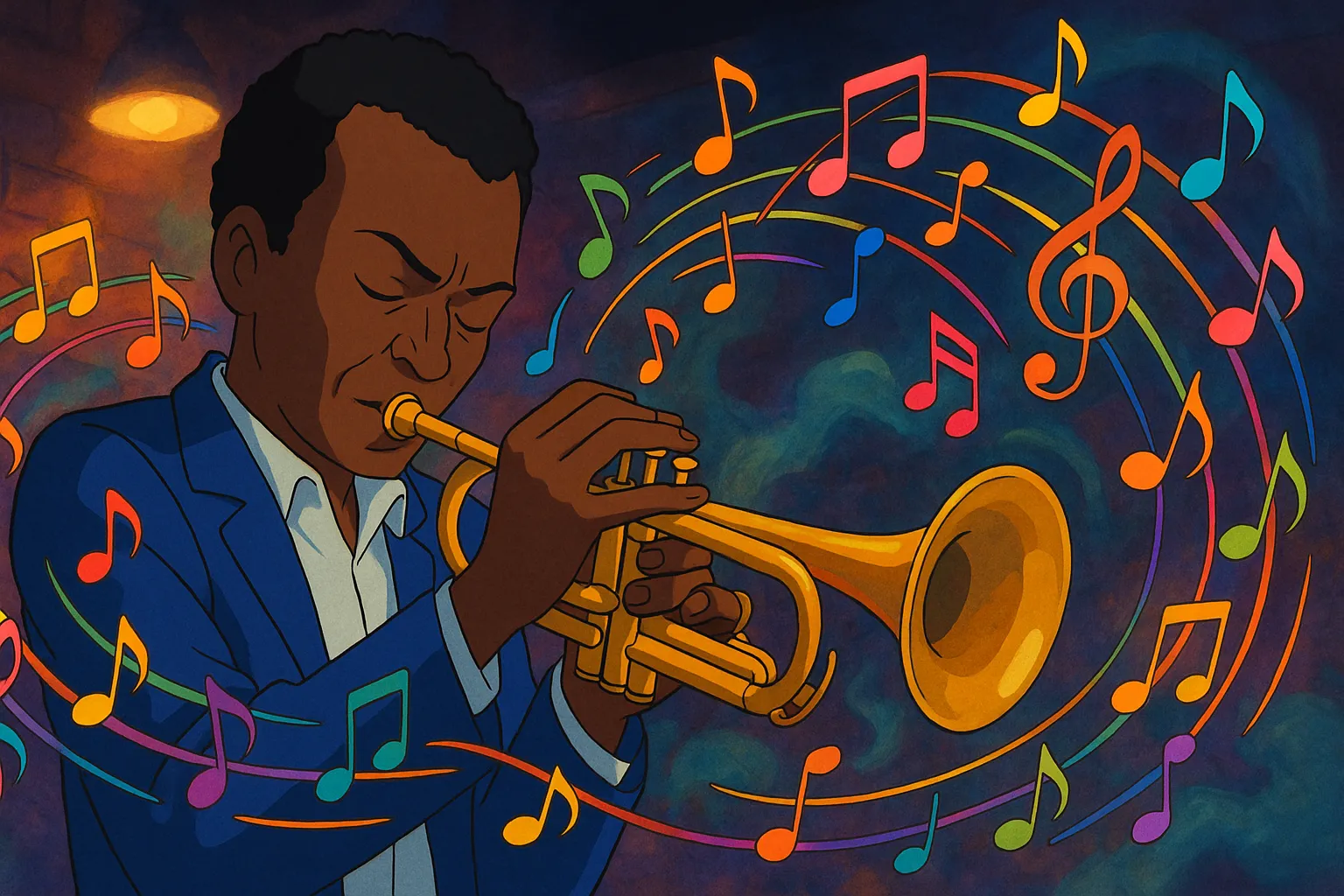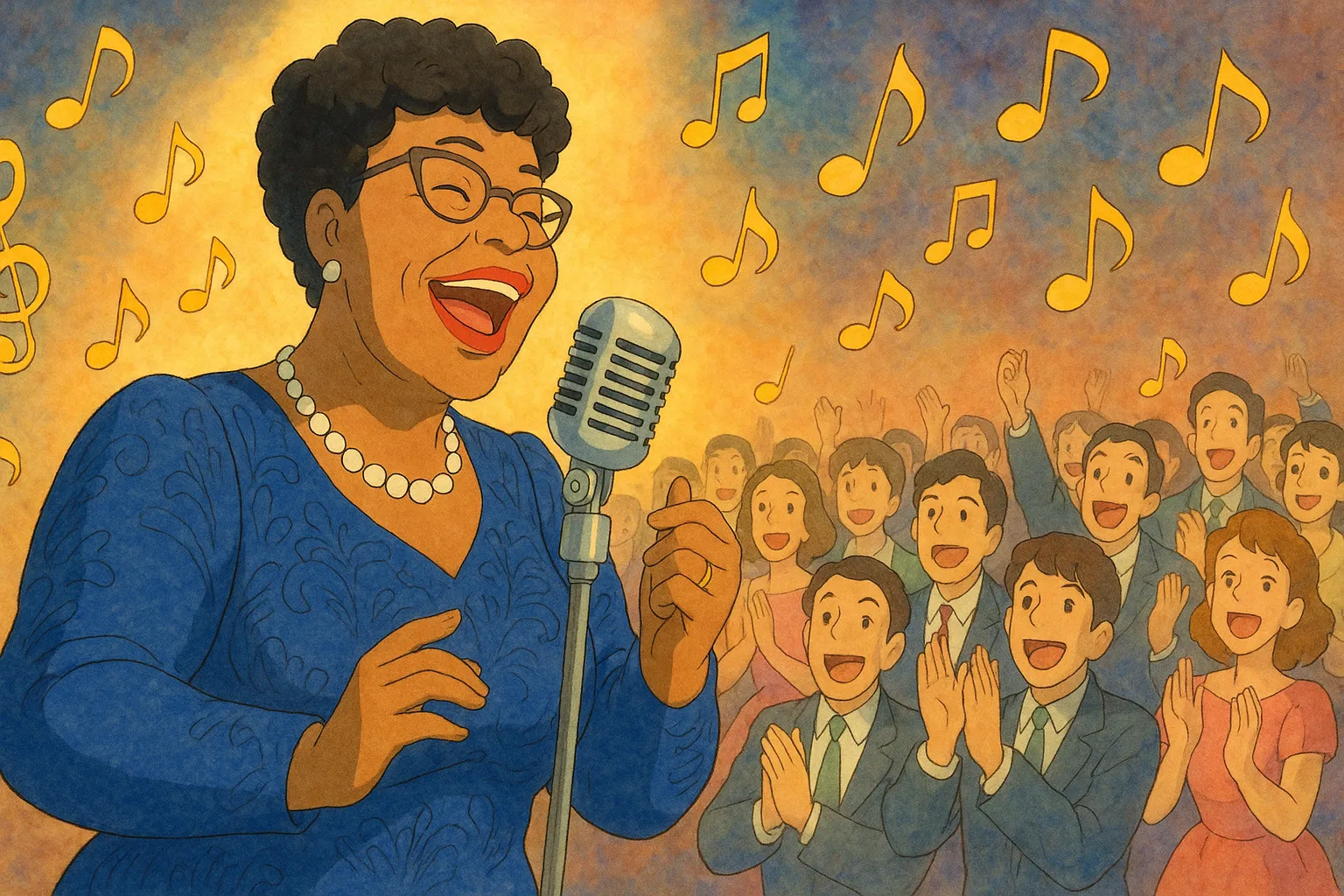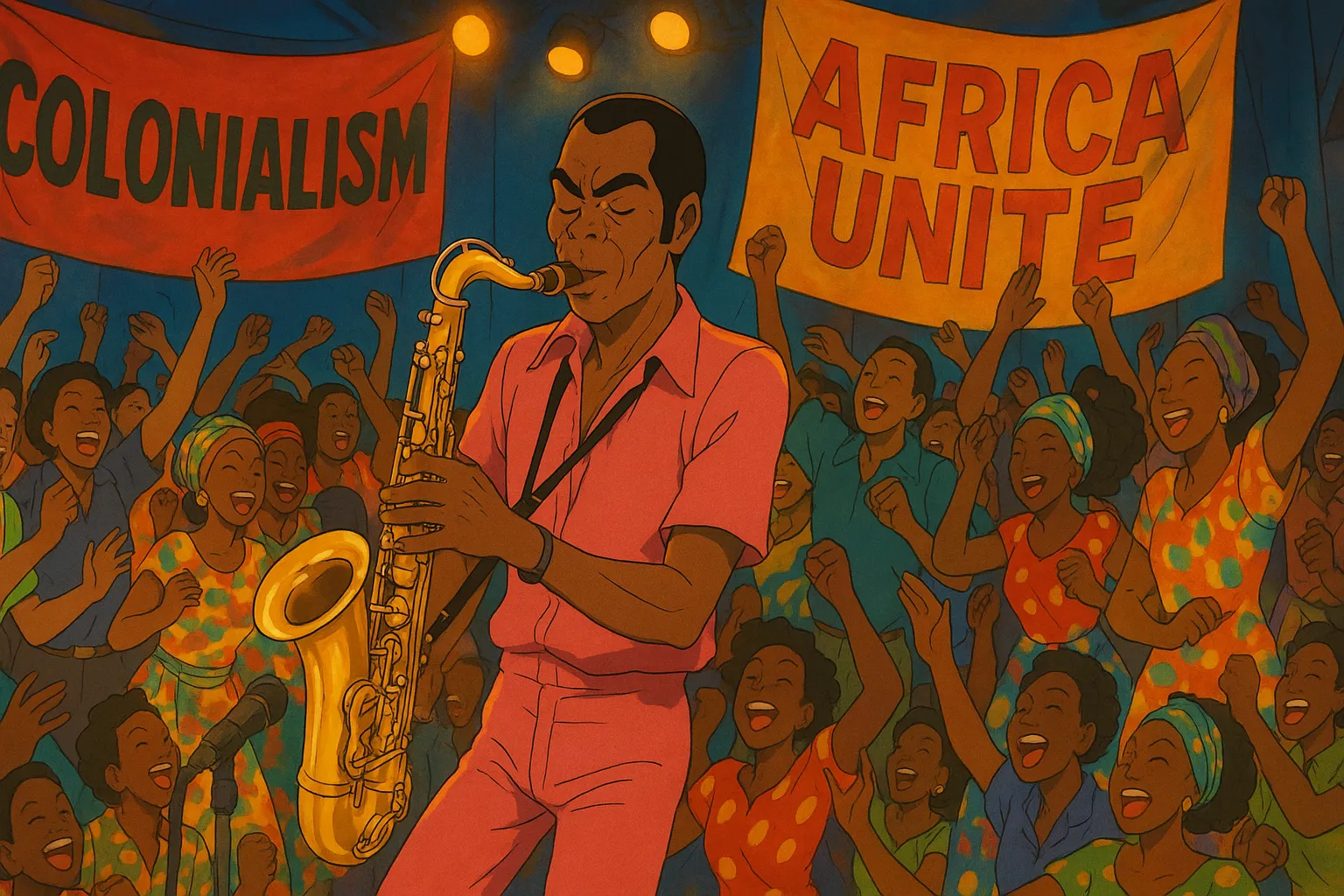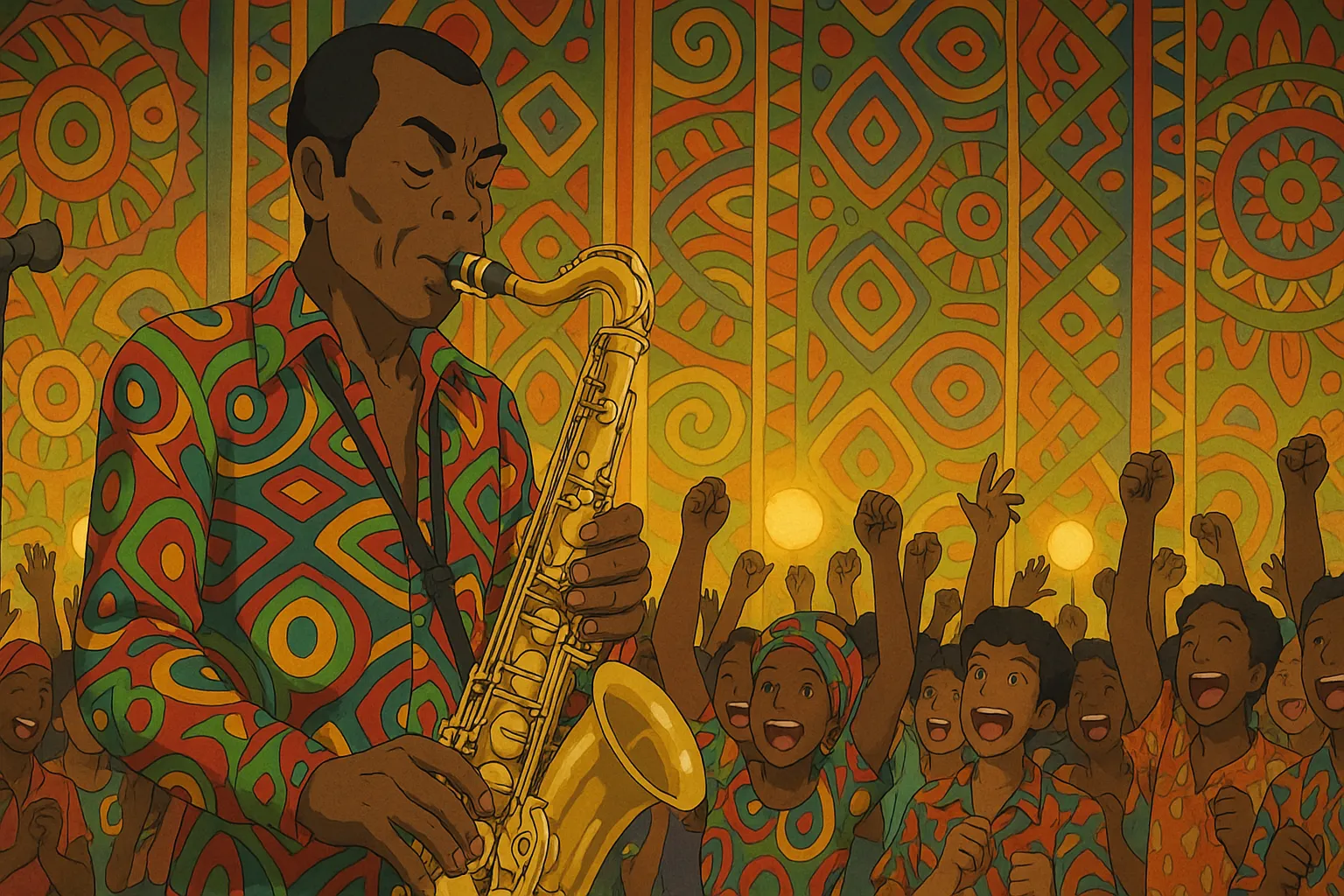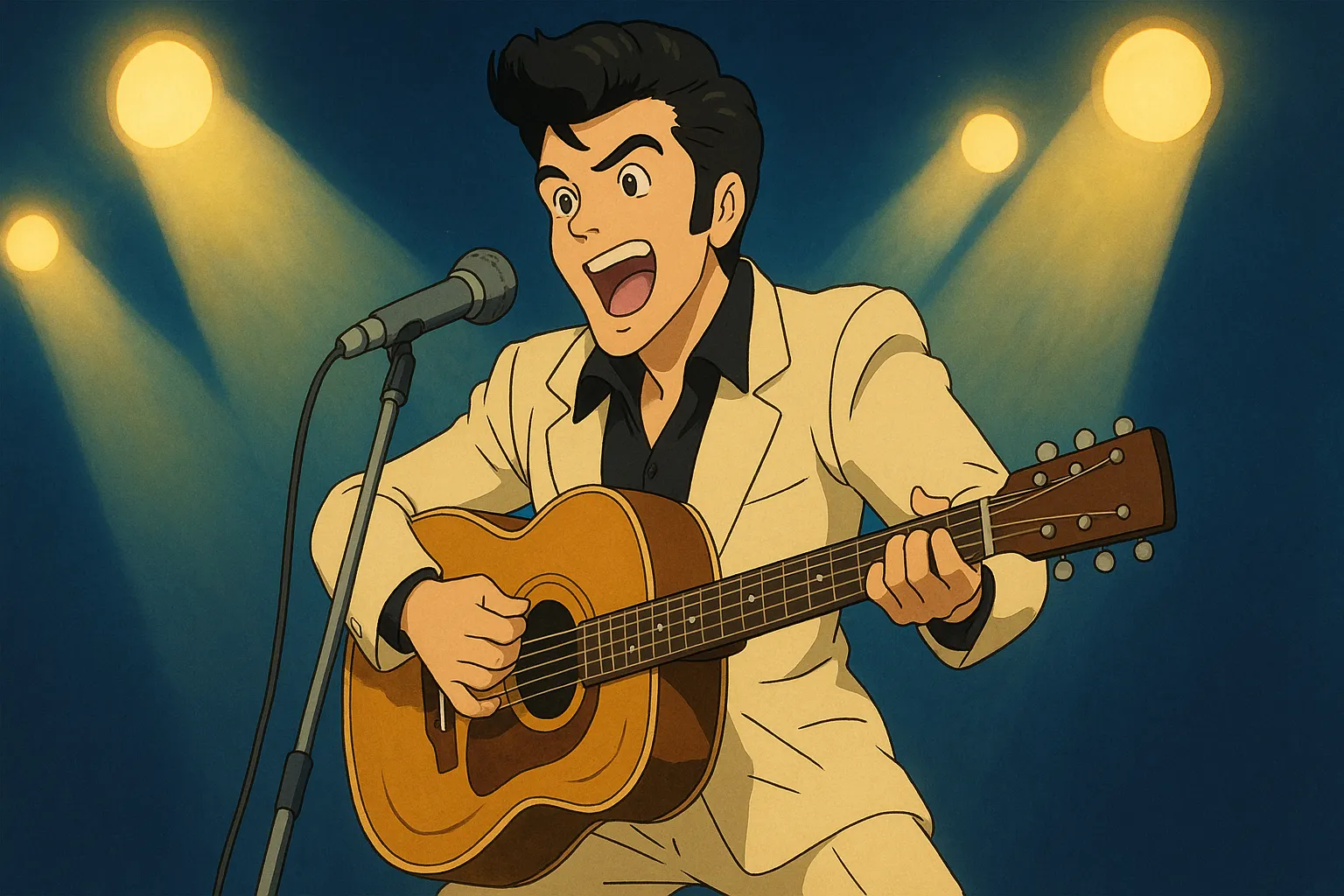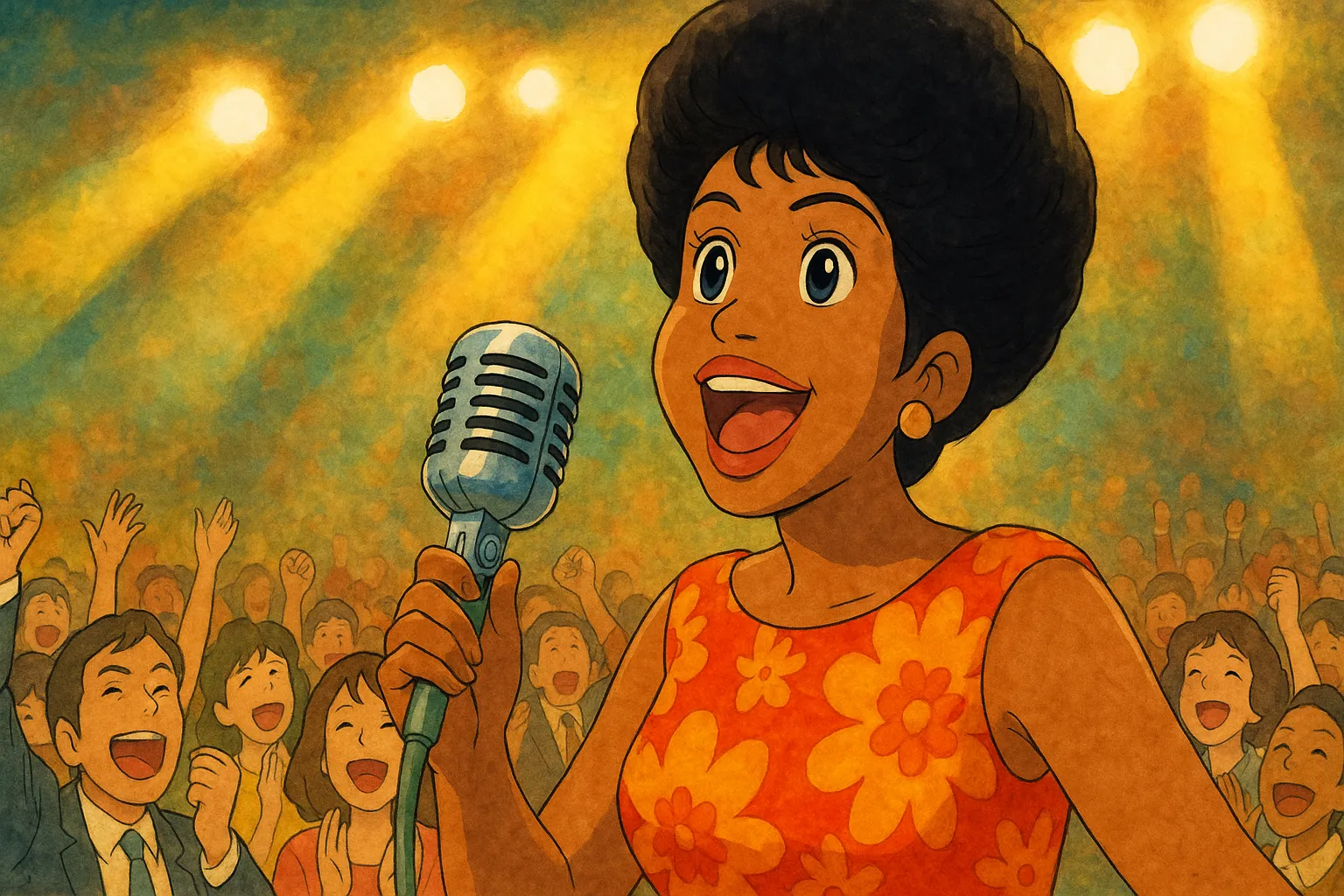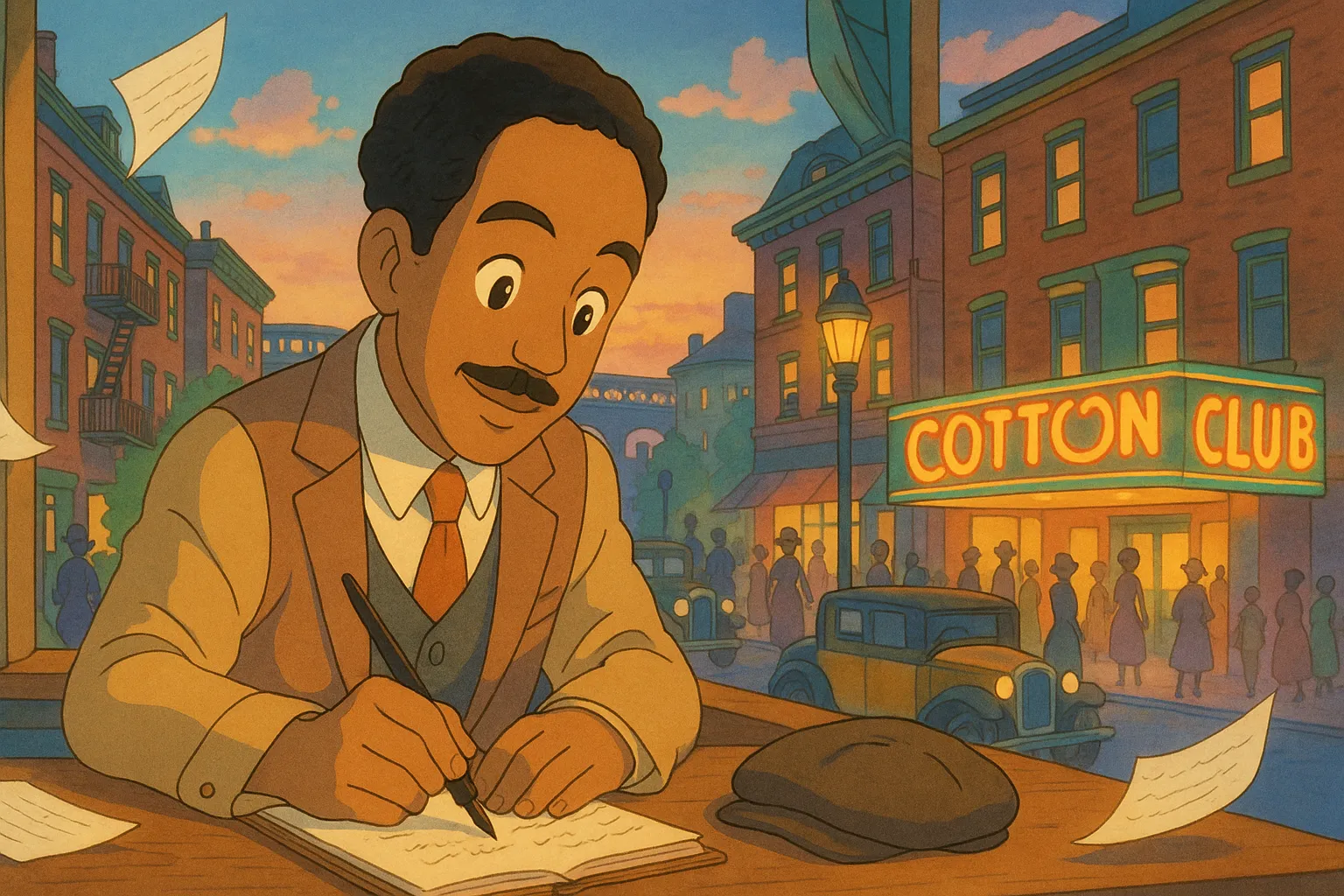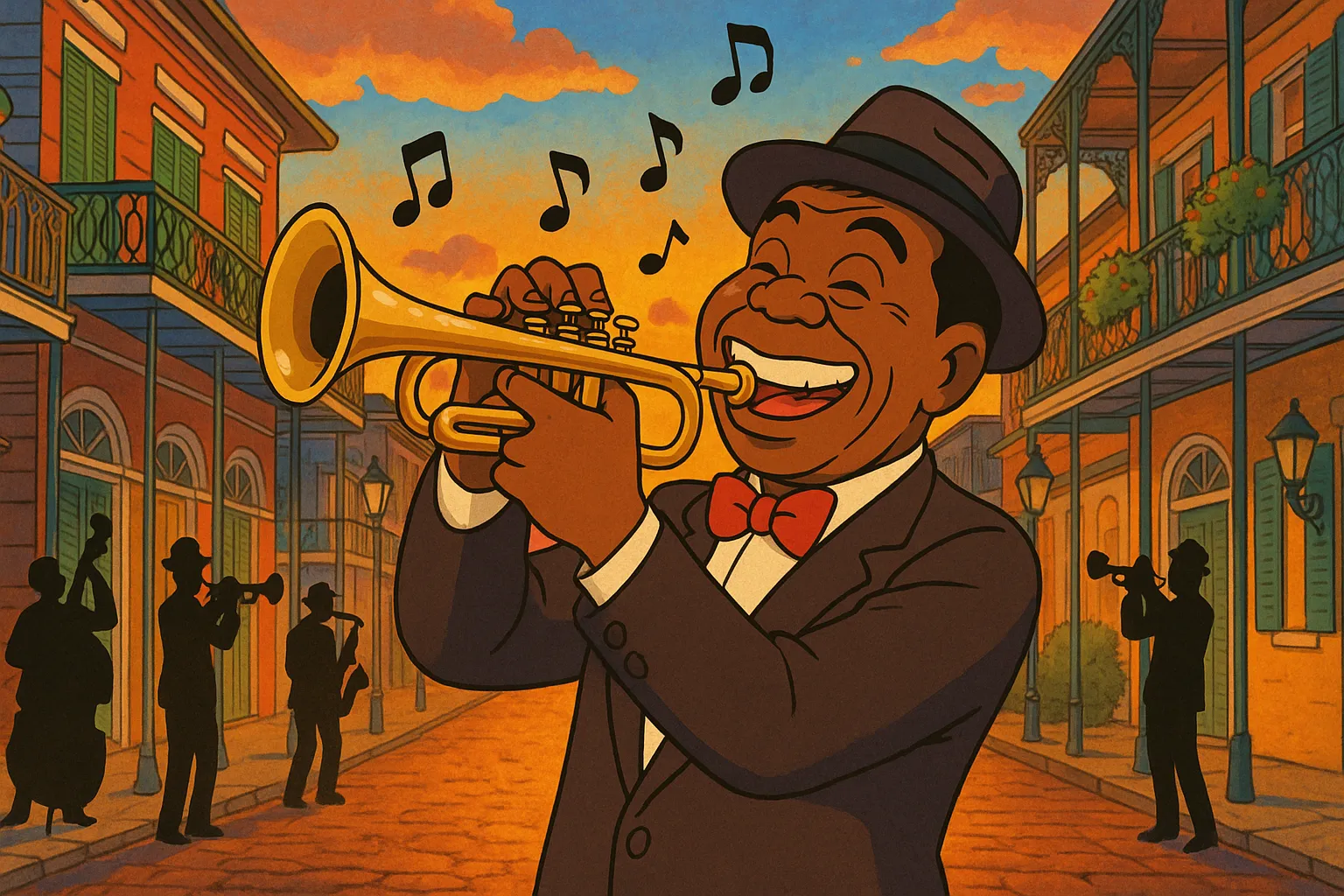
Frequently Asked Questions
What nicknames did Louis Armstrong have?
He was widely known as “Satchmo” (short for “satchel mouth”) and affectionately called “Pops” by fellow musicians and fans.
Did he start on cornet or trumpet?
He began his career on cornet and later moved to trumpet. Both instruments shaped his early sound, though he’s best remembered as a trumpet soloist.
Who mentored and collaborated with him?
Early mentor Joe “King” Oliver helped launch his career. He also worked closely with pianist Lil Hardin (who became his wife) and other leading bandleaders and pianists of his era.
Was he involved in civil rights issues?
His relationship with civil rights was complex: he experienced segregation, faced criticism at times for certain choices, yet his global fame and interracial audiences also challenged barriers.
Is there a museum dedicated to him?
Yes. His home is preserved as the Louis Armstrong House Museum in Queens, New York, which offers tours, archives, and educational programs.
Did he write music or books?
He co-wrote and popularized songs during his career and published autobiographical writings and memoirs that describe his life and musical journey.
Did he appear in movies or on television?
Yes. He made film and TV appearances—often playing himself—helping introduce jazz to broader, mainstream audiences worldwide.
Where can I hear his recordings today?
His recordings are widely available: reissued albums, streaming services, archival collections, and public institutions like the Library of Congress hold important recordings and documents.
References
- https://en.wikipedia.org/wiki/Louis_Armstrong
- https://www.britannica.com/biography/Louis-Armstrong
- https://louisarmstronghouse.org/legacy/biography/overview/overview/84/overview/86/overview/88/overview/90/overview/92/overview/94/overview/96/overview/98/overview/100/overview/102/overview/104/overview/106/overview/108/overview/110/overview/112/overview/114/overview/116/overview/118/overview/120/overview/122/overview/124/overview/126/overview/128/overview/130/overview/132/overview/134/overview/136/overview/138/overview/140/overview/142/overview/144/overview/146/overview/148/overview/150/overview/152/overview/154/overview/156/overview/158/overview/160/overview/162/overview/164/overview/166/overview/168/overview/170/overview/172/overview/174/overview/176/overview/178/overview/180/overview/182/overview/184/overview/186/overview/188/overview/190/overview/192/overview/194/overview/196/overview/198/overview/200/overview/202/overview/204/overview/206/overview/208/overview/210/overview/212/overview/214/overview/216/overview/218/overview/220/overview/222/overview/224/overview/226/overview/228/overview/230/overview/232/overview/234/overview/236/overview/238/overview/240/overview/242/overview/244/overview/246/overview/248/overview/250/overview/252/overview/254/overview/256/overview/258/overview/260/overview/262/overview/264/overview/266/overview/268/overview/270/overview/272/overview/274/overview/276/overview/278/overview/280/overview/282/overview/284/overview/286/overview/288/overview/290/overview/292/overview/294/overview/296/overview/298/overview/300/overview/302/overview/304/overview/306/overview/308/overview/310/overview/312/overview/314/overview/316/overview/318/overview/320/overview/322/overview/324/overview/326/overview/328/overview/330/overview/332/overview/334/overview/336/overview/338/overview/340/overview/342/overview/344/overview/346/overview/348/overview/350/overview/352/overview/354/overview/356/overview/358/overview/360/overview/362/overview/364/overview/366/overview/368/overview/370/overview/372/overview/374/overview/376/overview/378/overview/380/overview/382/overview/384/overview/386/overview/388/overview/390/overview/392/overview/394/overview/396/overview/398/overview/400/overview/402/overview/404/overview/406/overview/408/overview/410/overview/412/overview/414/overview/416/overview/418/overview/420/overview/422/overview/424/overview/426/overview/428/overview/430/overview/432/overview/434/overview/436/overview/438/overview/440/overview/442/overview/444/overview/446/overview/448/overview/450/overview/452/overview/454/overview/456/overview/458/overview/460/overview/462/overview/464/overview/466/overview/468/overview/470/overview/472/overview/474/overview/476/overview/478/overview/480/overview/482/overview/484/overview/486/overview/488/overview/490/overview/492/overview/494/overview/496/overview/498/overview/500/overview/502/overview/504/overview/506/overview/508/overview/510/overview/512/overview/514/overview/516/overview/518/overview/520/overview/522/overview/524/overview/526/overview/528/overview/530/overview/532/overview/534/overview/536/overview/538/overview/540/overview/542/overview/544/overview/546/overview/548/overview/550/overview/552/overview/554/overview/556/overview/558/overview/560/overview/562/overview/564/overview/566/overview/568/overview/570/overview/572/overview/574/overview/576/overview/578/overview/580/overview/582/overview/584/overview/586/overview/588/overview/590/overview/592/overview/594/overview/596/overview/598/overview/600/overview/602/overview/604/overview/606/overview/608/overview/610/overview/612/overview/614/overview/616/overview/618/overview/620/overview/622/overview/624/overview/626/overview/628/overview/630/overview/632/overview/634/overview/636/overview/638/overview/640/overview/642/overview/644/overview/646/overview/648/overview/650/overview/652/overview/654/overview/656/overview/658/overview/660/overview/662/overview/664/overview/666/overview/668/overview/670/overview/672/overview/674/overview/676/overview/678/overview/680/overview/682/overview/684/overview/686/overview/688/overview/690/overview/692/overview/694/overview/696/overview/698/overview/700/overview/702/overview/704/overview/706/overview/708/overview/710/overview/712/overview/714/overview/716/overview/718/overview/720/overview/722/overview/724/overview/726/overview/728/overview/730/overview/732/overview/734/overview/736/overview/738/overview/740/overview/742/overview/744/overview/746/overview/748/overview/750/overview/752/overview/754/overview/756/overview/758/overview/760/overview/762/overview/764/overview/766/overview/768/overview/770/overview/772/overview/774/overview/776/overview/778/overview/780/overview/782/overview/784/overview/786/overview/788/overview/790/overview/792/overview/794/overview/796/overview/798/overview/800/overview/802/overview/804/overview/806/overview/808/overview/810/overview/812/overview/814/overview/816/overview/818/overview/820/overview/822/overview/824/overview/826/overview/828/overview/830/overview/832/overview/834/overview/836/overview/838/overview/840/overview/842/overview/844/overview/846/overview/848/overview/850/overview/852/overview/854/overview/856/overview/858/overview/860/overview/862/overview/864/overview/866/overview/868/overview/870/overview/872/overview/874/overview/876/overview/878/overview/880/overview/882/overview/884/overview/886/overview/888/overview/890/overview/892/overview/894/overview/896/overview/898/overview/900/overview/902/overview/904/overview/906/overview/908/overview/910/overview/912/overview/914/overview/916/overview/918/overview/920/overview/922/overview/924/overview/926/overview/928/overview/930/overview/932/overview/934/overview/936/overview/938/overview/940/overview/942/overview/944/overview/946/overview/948/overview/950/overview/952/overview/954/overview/956/overview/958/overview/960/overview/962/overview/964/overview/966/overview/968/overview/970/overview/972/overview/974/overview/976/overview/978/overview/980/overview/982/overview/984/overview/986/overview/988/overview/990/overview/992/overview/994/overview/996/overview/998/overview/1000/overview/1002/overview/1004/overview/1006/overview/1008/overview/1010/overview/1012/overview/1014/overview/1016/overview/1018/overview/1020/overview/1022/overview/1024/overview/1026/overview/1028/overview/1030/overview/1032/overview/1034/overview/1036/overview/1038/overview/1040/overview/1042/overview/1044/overview/1046/overview/1048/overview/1050/overview/1052/overview/1054/overview/1056/overview/1058/overview/1060/overview/1062/overview/1064/overview/1066/overview/1068/overview/1070/overview/1072/overview/1074/overview/1076/overview/1078/overview/1080/overview/1082/overview/1084/overview/1086/overview/1088/overview/1090/overview/1092/overview/1094/overview/1096/overview/1098/overview/1100/overview/1102/overview/1104/overview/1106/overview/1108/overview/1110/overview/1112/overview/1114/overview/1116/overview/1118/overview/1120/overview/1122/overview/1124/overview/1126/overview/1128/overview/1130/overview/1132/overview/1134/overview/1136/overview/1138/overview/1140/overview/1142/overview/1144/overview/1146/overview/1148/overview/1150/overview/1152/overview/1154/overview/1156/overview/1158/overview/1160/overview/1162/overview/1164/overview/1166/overview/1168/overview/1170/overview/1172/overview/1174/overview/1176/overview/1178/overview/1180/overview/1182/overview/1184/overview/1186/overview/1188/overview/1190/overview/1192/overview/1194/overview/1196/overview/1198/overview/1200/overview/1202/overview/1204/overview/1206/overview/1208/overview/1210/overview/1212/overview/1214/overview/1216/overview/1218/overview/1220/overview/1222/overview/1224/overview/1226/overview/1228/overview/1230/overview/1232/overview/1234/overview/1236/overview/1238/overview/1240/overview/1242/overview/1244/overview/1246/overview/1248/overview/1250/overview/1252/overview/1254/overview/1256/overview/1258/overview/1260/overview/1262/overview/1264/overview/1266/overview/1268/overview/1270/overview/1272/overview/1274/overview/1276/overview/1278/overview/1280/overview/1282/overview/1284/overview/1286/overview/1288/overview/1290/overview/1292/overview/1294/overview/1296/overview/1298/overview/1300/overview/1302/overview/1304/overview/1306/overview/1308/overview/1310/overview/1312/overview/1314/overview/1316/overview/1318/overview/1320/overview/1322/overview/1324/overview/1326/overview/1328/overview/1330/overview/1332/overview/1334/overview/1336/overview/1338/overview/1340/overview/1342/overview/1344/overview/1346/overview/1348/overview/1350/overview/1352/overview/1354/overview/1356/overview/1358/overview/1360/overview/1362/overview/1364/overview/1366/overview/1368/overview/1370/overview/1372/overview/1374/overview/1376/overview/1378/overview/1380/overview/1382/overview/1384/overview/1386/overview/1388/overview/1390/overview/1392/overview/1394/overview/1396/overview/1398/overview/1400/overview/1402/overview/1404/overview/1406/overview/1408/overview/1410/overview/1412/overview/1414/overview/1416/overview/1418/overview/1420/overview/1422/overview/1424/overview/1426/overview/1428/overview/1430/overview/1432/overview/1434/overview/1436/overview/1438/overview/1440/overview/1442/overview/1444/overview/1446/overview/1448/overview/1450/overview/1452/overview/1454/overview/1456/overview/1458/overview/1460/overview/1462/overview/1464/overview/1466/overview/1468/overview/1470/overview/1472/overview/1474/overview/1476/overview/1478/overview/1480/overview/1482/overview/1484/overview/1486/overview/1488/overview/1490/overview/1492/overview/1494/overview/1496/overview/1498/overview/1500/overview/1502/overview/1504/overview/1506/overview/1508/overview/1510/overview/1512/overview/1514/overview/1516/overview/1518/overview/1520/overview/1522/overview/1524/overview/1526/overview/1528/overview/1530/overview/1532/overview/1534/overview/1536/overview/1538/overview/1540/overview/1542/overview/1544/overview/1546/overview/1548/overview/1550/overview/1552/overview/1554/overview/1556/overview/1558/overview/1560/overview/1562/overview/1564/overview/1566/overview/1568/overview/1570/overview/1572/overview/1574/overview/1576/overview/1578/overview/1580/overview/1582/overview/1584/overview/1586/overview/1588/overview/1590/overview/1592/overview/1594/overview/1596/overview/1598/overview/1600/overview/1602/overview/1604/overview/1606/overview/1608/overview/1610/overview/1612/overview/1614/overview/1616/overview/1618/overview/1620/overview/1622/overview/1624/overview/1626/overview/1628/overview/1630/overview/1632/overview/1634/overview/1636/overview/1638/overview/1640/overview/1642/overview/1644/overview/1646/overview/1648/overview/1650/overview/1652/overview/1654/overview/1656/overview/1658/overview/1660/overview/1662/overview/1664/overview/1666/overview/1668/overview/1670/overview/1672/overview/1674/overview/1676/overview/1678/overview/1680/overview/1682/overview/1684/overview/1686/overview/1688/overview/1690/overview/1692/overview/1694/overview/1696/overview/1698/overview/1700/overview/1702/overview/1704/overview/1706/overview/1708/overview/1710/overview/1712/overview/1714/overview/1716/overview/1718/overview/1720/overview/1722/overview/1724/overview/1726/overview/1728/overview/1730/overview/1732/overview/1734/overview/1736/overview/1738/overview/1740/overview/1742/overview/1744/overview/1746/overview/1748/overview/1750/overview/1752/overview/1754/overview/1756/overview/1758/overview/1760/overview/1762/overview/1764/overview/1766/overview/1768/overview/1770/overview/1772/overview/1774/overview/1776/overview/1778/overview/1780/overview/1782/overview/1784/overview/1786/overview/1788/overview/1790/overview/1792/overview/1794/overview/1796/overview/1798/overview/1800/overview/1802/overview/1804/overview/1806/overview/1808/overview/1810/overview/1812/overview/1814/overview/1816/overview/1818/overview/1820/overview/1822/overview/1824/overview/1826/overview/1828/overview/1830/overview/1832/overview/1834/overview/1836/overview/1838/overview/1840/overview/1842/overview/1844/overview/1846/overview/1848/overview/1850/overview/1852/overview/1854/overview/1856/overview/1858/overview/1860/overview/1862/overview/1864/overview/1866/overview/1868/overview/1870/overview/1872/overview/1874/overview/1876/overview/1878/overview/1880/overview/1882/overview/1884/overview/1886/overview/1888/overview/1890/overview/1892/overview/1894/overview/1896/overview/1898/overview/1900/overview/1902/overview/1904/overview/1906/overview/1908/overview/1910/overview/1912/overview/1914/overview/1916/overview/1918/overview/1920/overview/1922/overview/1924/overview/1926/overview/1928/overview/1930/overview/1932/overview/1934/overview/1936/overview/1938/overview/1940/overview/1942/overview/1944/overview/1946/overview/1948/overview/1950/overview/1952/overview/1954/overview/1956/overview/1958/overview/1960/overview/1962/overview/1964/overview/1966/overview/1968/overview/1970/overview/1972/overview/1974/overview/1976/overview/1978/overview/1980/overview/1982/overview/1984/overview/1986/overview/1988/overview/1990/overview/1992/overview/1994/overview/1996/overview/1998/overview/2000/overview/2002/overview/2004/overview/2006/overview/2008/overview/2010/overview/2012/overview/2014/overview/2016/overview/2018/overview/2020/overview/2022/overview/2024/overview/2026/overview/2028/overview/2030/overview/2032/overview/2034/overview/2036/overview/2038/overview/2040/overview/2042/overview/2044/overview/2046/overview/2048/overview/2050/overview/2052/overview/2054/overview/2056/overview/2058/overview/2060/overview/2062/overview/2064/overview/2066/overview/2068/overview/2070/overview/2072/overview/2074/overview/2076/overview/2078/overview/2080/overview/2082/overview/2084/overview/2086/overview/2088/overview/2090/overview/2092/overview/2094/overview/2096/overview/2098/overview/2100/overview/2102/overview/2104/overview/2106/overview/2108/overview/2110/overview/2112/overview/2114/overview/2116/overview/2118/overview/2120/overview/2122/overview/2124/overview/2126/overview/2128/overview/2130/overview/2132/overview/2134/overview/2136/overview/2138/overview/2140/overview/2142/overview/2144/overview/2146/overview/2148/overview/2150/overview/2152/overview/2154/overview/2156/overview/2158/overview/2160/overview/2162/overview/2164/overview/2166/overview/2168/overview/2170/overview/2172/overview/2174/overview/2176/overview/2178/overview/2180/overview/2182/overview/2184/overview/2186/overview/2188/overview/2190/overview/2192/overview/2194/overview/2196/overview/2198/overview/2200/overview/2202/overview/2204/overview/2206/overview/2208/overview/2210/overview/2212/overview/2214/overview/2216/overview/2218/overview/2220/overview/2222/overview/2224/overview/2226/overview/2228/overview/2230/overview/2232/overview/2234/overview/2236/overview/2238/overview/2240/overview/2242/overview/2244/overview/2246/overview/2248/overview/2250/overview/2252/overview/2254/overview/2256/overview/2258/overview/2260/overview/2262/overview/2264/overview/2266/overview/2268/overview/2270/overview/2272/overview/2274/overview/2276/overview/2278/overview/2280/overview/2282/overview/2284/overview/2286/overview/2288/overview/2290/overview/2292/overview/2294/overview/2296/overview/2298/overview/2300/overview/2302/overview/2304/overview/2306/overview/2308/overview/2310/overview/2312/overview/2314/overview/2316/overview/2318/overview/2320/overview/2322/overview/2324/overview/2326/overview/2328/overview/2330/overview/2332/overview/2334/overview/2336/overview/2338/overview/2340/overview/2342/overview/2344/overview/2346/overview/2348/overview/2350/overview/2352/overview/2354/overview/2356/overview/2358/overview/2360/overview/2362/overview/2364/overview/2366/overview/2368/overview/2370/overview/2372/overview/2374/overview/2376/overview/2378/overview/2380/overview/2382/overview/2384/overview/2386/overview/2388/overview/2390/overview/2392/overview/2394/overview/2396/overview/2398/overview/2400/overview/2402/overview/2404/overview/2406/overview/2408/overview/2410/overview/2412/overview/2414/overview/2416/overview/2418/overview/2420/overview/2422/overview/2424/overview/2426/overview/2428/overview/2430/overview/2432/overview/2434/overview/2436/overview/2438/overview/2440/overview/2442/overview/2444/overview/2446/overview/2448/overview/2450/overview/2452/overview/2454/overview/2456/overview/2458/overview/2460/overview/2462/overview/2464/overview/2466/overview/2468/overview/2470/overview/2472/overview/2474/overview/2476/overview/2478/overview/2480/overview/2482/overview/2484/overview/2486/overview/2488/overview/2490/overview/2492/overview/2494/overview/2496/overview/2498/overview/2500/overview/2502/overview/2504/overview/2506/overview/2508/overview/2510/overview/2512/overview/2514/overview/2516/overview/2518/overview/2520/overview/2522/overview/2524/overview/2526/overview/2528/overview/2530/overview/2532/overview/2534/overview/2536/overview/2538/overview/2540/overview/2542/overview/2544/overview/2546/overview/2548/overview/2550/overview/2552/overview/2554/overview/2556/overview/2558/overview/2560/overview/2562/overview/2564/overview/2566/overview/2568/overview/2570/overview/2572/overview/2574/overview/2576/overview/2578/overview/2580/overview/2582/overview/2584/overview/2586/overview/2588/overview/2590/overview/2592/overview/2594/overview/2596/overview/2598/overview/2600/overview/2602/overview/2604/overview/2606/overview/2608/overview/2610/overview/2612/overview/2614/overview/2616/overview/2618/overview/2620/overview/2622/overview/2624/overview/2626/overview/2628/overview/2630/overview/2632/overview/2634/overview/2636/overview/2638/overview/2640/overview/2642/overview/2644/overview/2646/overview/2648/overview/2650/overview/2652/overview/2654/overview/2656/overview/2658/overview/2660/overview/2662/overview/2664/overview/2666/overview/2668/overview/2670/overview/2672/overview/2674/overview/2676/overview/2678/overview/2680/overview/2682/overview/2684/overview/2686/overview/2688/overview/2690/overview/2692/overview/2694/overview/2696/overview/2698/overview/2700/overview/2702/overview/2704/overview/2706/overview/2708/overview/2710/overview/2712/overview/2714/overview/2716/overview/2718/overview/2720/overview/2722/overview/2724/overview/2726/overview/2728/overview/2730/overview/2732/overview/2734/overview/2736/overview/2738/overview/2740/overview/2742/overview/2744/overview/2746/overview/2748/overview/2750/overview/2752/overview/2754/overview/2756/overview/2758/overview/2760/overview/2762/overview/2764/overview/2766/overview/2768/overview/2770/overview/2772/overview/2774/overview/2776/overview/2778/overview/2780/overview/2782/overview/2784/overview/2786/overview/2788/overview/2790/overview/2792/overview/2794/overview/2796/overview/2798/overview/2800/overview/2802/overview/2804/overview/2806/overview/2808/overview/2810/overview/2812/overview/2814/overview/2816/overview/2818/overview/2820/overview/2822/overview/2824/overview/2826/overview/2828/overview/2830/overview/2832/overview/2834/overview/2836/overview/2838/overview/2840/overview/2842/overview/2844/overview/2846/overview/2848/overview/2850/overview/2852/overview/2854/overview/2856/overview/2858/overview/2860/overview/2862/overview/2864/overview/2866/overview/2868/overview/2870/overview/2872/overview/2874/overview/2876/overview/2878/overview/2880/overview/2882/overview/2884/overview/2886/overview/2888/overview/2890/overview/2892/overview/2894/overview/2896/overview/2898/overview/2900/overview/2902/overview/2904/overview/2906/overview/2908/overview/2910/overview/2912/overview/2914/overview/2916/overview/2918/overview/2920/overview/2922/overview/2924/overview/2926/overview/2928/overview/2930/overview/2932/overview/2934/overview/2936/overview/2938/overview/2940/overview/2942/overview/2944/overview/2946/overview/2948/overview/2950/overview/2952/overview/2954/overview/2956/overview/2958/overview/2960/overview/2962/overview/2964/overview/2966/overview/2968/overview/2970/overview/2972/overview/2974/overview/2976/overview/2978/overview/2980/overview/2982/overview/2984/overview/2986/overview/2988/overview/2990/overview/2992/overview/2994/overview/2996/overview/2998/overview/3000/overview/3002/overview/3004/overview/3006/overview/3008/overview/3010/overview/3012/overview/3014/overview/3016/overview/3018/overview/3020/overview/3022/overview/3024/overview/3026/overview/3028/overview/3030/overview/3032/overview/3034/overview/3036/overview/3038/overview/3040/overview/3042/overview/3044/overview/3046/overview/3048/overview/3050/overview/3052/overview/3054/overview/3056/overview/3058/overview/3060/overview/3062/overview/3064/overview/3066/overview/3068/overview/3070/overview/3072/overview/3074/overview/3076/overview/3078/overview/3080/overview/3082/overview/3084/overview/3086/overview/3088/overview/3090/overview/3092/overview/3094/overview/3096/overview/3098/overview/3100/overview/3102/overview/3104/overview/3106/overview/3108/overview/3110/overview/3112/overview/3114/overview/3116/overview/3118/overview/3120/overview/3122/overview/3124/overview/3126/overview/3128/overview/3130/overview/3132/overview/3134/overview/3136/overview/3138/overview/3140/overview/3142/overview/3144/overview/3146/overview/3148/overview/3150/overview/3152/overview/3154/overview/3156/overview/3158/overview/3160/overview/3162/overview/3164/overview/3166/overview/3168/overview/3170/overview/3172/overview/3174/overview/3176/overview/3178/overview/3180/overview/3182/overview/3184/overview/3186/overview/3188/overview/3190/overview/3192/overview/3194/overview/3196/overview/3198/overview/3200/overview/3202/overview/3204/overview/3206/overview/3208/overview/3210/overview/3212/overview/3214/overview/3216/overview/3218/overview/3220/overview/3222/overview/3224/overview/3226/overview/3228/overview/3230/overview/3232/overview/3234/overview/3236/overview/3238/overview/3240/overview/3242/overview/3244/overview/3246/overview/3248/overview/3250/overview/3252/overview/3254/overview/3256/overview/3258/overview/3260/overview/3262/overview/3264/overview/3266/overview/3268/overview/3270/overview/3272/overview/3274/overview/3276/overview/3278/overview/3280/overview/3282/overview/3284/overview/3286/overview/3288/overview/3290/overview/3292/overview/3294/overview/3296/overview/3298/overview/3300/overview/3302/overview/3304/overview/3306/overview/3308/overview/3310/overview/3312/overview/3314/overview/3316/overview/3318/overview/3320/overview/3322/overview/3324/overview/3326/overview/3328/overview/3330/overview/3332/overview/3334/overview/3336/overview/3338/overview/3340/overview/3342/overview/3344/overview/3346/overview/3348/overview/3350/overview/3352/overview/3354/overview/3356/overview/3358/overview/3360/overview/3362/overview/3364/overview/3366/overview/3368/overview/3370/overview/3372/overview/3374/overview/3376/overview/3378/overview/3380/overview/3382/overview/3384/overview/3386/overview/3388/overview/3390/overview/3392/overview/3394/overview/3396/overview/3398/overview/3400/overview/3402/overview/3404/overview/3406/overview/3408/overview/3410/overview/3412/overview/3414/overview/3416/overview/3418/overview/3420/overview/3422/overview/3424/overview/3426/overview/3428/overview/3430/overview/3432/overview/3434/overview/3436/overview/3438/overview/3440/overview/3442/overview/3444/overview/3446/overview/3448/overview/3450/overview/3452/overview/3454/overview/3456/overview/3458/overview/3460/overview/3462/overview/3464/overview/3466/overview/3468/overview/3470/overview/3472/overview/3474/overview/3476/overview/3478/overview/3480/overview/3482/overview/3484/overview/3486/overview/3488/overview/3490/overview/3492/overview/3494/overview/3496/overview/3498/overview/3500/overview/3502/overview/3504/overview/3506/overview/3508/overview/3510/overview/3512/overview/3514/overview/3516/overview/3518/overview/3520/overview/3522/overview/3524/overview/3526/overview/3528/overview/3530/overview/3532/overview/3534/overview/3536/overview/3538/overview/3540/overview/3542/overview/3544/overview/3546/overview/3548/overview/3550/overview/3552/overview/3554/overview/3556/overview/3558/overview/3560/overview/3562/overview/3564/overview/3566/overview/3568/overview/3570/overview/3572/overview/3574/overview/3576/overview/3578/overview/3580/overview/3582/overview/3584/overview/3586/overview/3588/overview/3590/overview/3592/overview/3594/overview/3596/overview/3598/overview/3600/overview/3602/overview/3604/overview/3606/overview/3608/overview/3610/overview/3612/overview/3614/overview/3616/overview/3618/overview/3620/overview/3622/overview/3624/overview/3626/overview/3628/overview/3630/overview/3632/overview/3634/overview/3636/overview/3638/overview/3640/overview/3642/overview/3644/overview/3646/overview/3648/overview/3650/overview/3652/overview/3654/overview/3656/overview/3658/overview/3660/overview/3662/overview/3664/overview/3666/overview/3668/overview/3670/overview/3672/overview/3674/overview/3676/overview/3678/overview/3680/overview/3682/overview/3684/overview/3686/overview/3688/overview/3690/overview/3692/overview/3694/overview/3696/overview/3698/overview/3700/overview/3702/overview/3704/overview/3706/overview/3708/overview/3710/overview/3712/overview/3714/overview/3716/overview/3718/overview/3720/overview/3722/overview/3724/overview/3726/overview/3728/overview/3730/overview/3732/overview/3734/overview/3736/overview/3738/overview/3740/overview/3742/overview/3744/overview/3746/overview/3748/overview/3750/overview/3752/overview/3754/overview/3756/overview/3758/overview/3760/overview/3762/overview/3764/overview/3766/overview/3768/overview/3770/overview/3772/overview/3774/overview/3776/overview/3778/overview/3780/overview/3782/overview/3784/overview/3786/overview/3788/overview/3790/overview/3792/overview/3794/overview/3796/overview/3798/overview/3800/overview/3802/overview/3804/overview/3806/overview/3808/overview/3810/overview/3812/overview/3814/overview/3816/overview/3818/overview/3820/overview/3822/overview/3824/overview/3826/overview/3828/overview/3830/overview/3832/overview/3834/overview/3836/overview/3838/overview/3840/overview/3842/overview/3844/overview/3846/overview/3848/overview/3850/overview/3852/overview/3854/overview/3856/overview/3858/overview/3860/overview/3862/overview/3864/overview/3866/overview/3868/overview/3870/overview/3872/overview/3874/overview/3876/overview/3878/overview/3880/overview/3882/overview/3884/overview/3886/overview/3888/overview/3890/overview/3892/overview/3894/overview/3896/overview/3898/overview/3900/overview/3902/overview/3904/overview/3906/overview/3908/overview/3910/overview/3912/overview/3914/overview/3916/overview/3918/overview/3920/overview/3922/overview/3924/overview/3926/overview/3928/overview/3930/overview/3932/overview/3934/overview/3936/overview/3938/overview/3940/overview/3942/overview/3944/overview/3946/overview/3948/overview/3950/overview/3952/overview/3954/overview/3956/overview/3958/overview/3960/overview/3962/overview/3964/overview/3966/overview/3968/overview/3970/overview/3972/overview/3974/overview/3976/overview/3978/overview/3980/overview/3982/overview/3984/overview/3986/overview/3988/overview/3990/overview/3992/overview/3994/overview/3996/overview/3998/overview/4000/overview/4002/overview/4004/overview/4006/overview/4008/overview/4010/overview/4012/overview/4014/overview/4016/overview/4018/overview/4020/overview/4022/overview/4024/overview/4026/overview/4028/overview/4030/overview/4032/overview/4034/overview/4036/overview/4038/overview/4040/overview/4042/overview/4044/overview/4046/overview/4048/overview/4050/overview/4052/overview/4054/overview/4056/overview/4058/overview/4060/overview/4062/overview/4064/overview/4066/overview/4068/overview/4070/overview/4072/overview/4074/overview/4076/overview/4078/overview/4080/overview/4082/overview/4084/overview/4086/overview/4088/overview/4090/overview/4092/overview/4094/overview/4096/overview/4098/overview/4100/overview/4102/overview/4104/overview/4106/overview/4108/overview/4110/overview/4112/overview/4114/overview/4116/overview/4118/overview/4120/overview/4122/overview/4124/overview/4126/overview/4128/overview/4130/overview/4132/overview/4134/overview/4136/overview/4138/overview/4140/overview/4142/overview/4144/overview/4146/overview/4148/overview/4150/overview/4152/overview/4154/overview/4156/overview/4158/overview/4160/overview/4162/overview/4164/overview/4166/overview/4168/overview/4170/overview/4172/overview/4174/overview/4176/overview/4178/overview/4180/overview/4182/overview/4184/overview/4186/overview/4188/overview/4190/overview/4192/overview/4194/overview/4196/overview/4198/overview/4200/overview/4202/overview/4204/overview/4206/overview/4208/overview/4210/overview/4212/overview/4214/overview/4216/overview/4218/overview/4220/overview/4222/overview/4224/overview/4226/overview/4228/overview/4230/overview/4232/overview/4234/overview/4236/overview/4238/overview/4240/overview/4242/overview/4244/overview/4246/overview/4248/overview/4250/overview/4252/overview/4254/overview/4256/overview/4258/overview/4260/overview/4262/overview/4264/overview/4266/overview/4268/overview/4270/overview/4272/overview/4274/overview/4276/overview/4278/overview/4280/overview/4282/overview/4284/overview/4286/overview/4288/overview/4290/overview/4292/overview/4294/overview/4296/overview/4298/overview/4300/overview/4302/overview/4304/overview/4306/overview/4308/overview/4310/overview/4312/overview/4314/overview/4316/overview/4318/overview/4320/overview/4322/overview/4324/overview/4326/overview/4328/overview/4330/overview/4332/overview/4334/overview/4336/overview/4338/overview/4340/overview/4342/overview/4344/overview/4346/overview/4348/overview/4350/overview/4352/overview/4354/overview/4356/overview/4358/overview/4360/overview/4362/overview/4364/overview/4366/overview/4368/overview/4370/overview/4372/overview/4374/overview/4376/overview/4378/overview/4380/overview/4382/overview/4384/overview/4386/overview/4388/overview/4390/overview/4392/overview/4394/overview/4396/overview/4398/overview/4400/overview/4402/overview/4404/overview/4406/overview/4408/overview/4410/overview/4412/overview/4414/overview/4416/overview/4418/overview/4420/overview/4422/overview/4424/overview/4426/overview/4428/overview/4430/overview/4432/overview/4434/overview/4436/overview/4438/overview/4440/overview/4442/overview/4444/overview/4446/overview/4448/overview/4450/overview/4452/overview/4454/overview/4456/overview/4458/overview/4460/overview/4462/overview/4464/overview/4466/overview/4468/overview/4470/overview/4472/overview/4474/overview/4476/overview/4478/overview/4480/overview/4482/overview/4484/overview/4486/overview/4488/overview/4490/overview/4492/overview/4494/overview/4496/overview/4498/overview/4500/overview/4502/overview/4504/overview/4506/overview/4508/overview/4510/overview/4512/overview/4514/overview/4516/overview/4518/overview/4520/overview/4522/overview/4524/overview/4526/overview/4528/overview/4530/overview/4532/overview/4534/overview/4536/overview/4538/overview/4540/overview/4542/overview/4544/overview/4546/overview/4548/overview/4550/overview/4552/overview/4554/overview/4556/overview/4558/overview/4560/overview/4562/overview/4564/overview/4566/overview/4568/overview/4570/overview/4572/overview/4574/overview/4576/overview/4578/overview/4580/overview/4582/overview/4584/overview/4586/overview/4588/overview/4590/overview/4592/overview/4594/overview/4596/overview/4598/overview/4600/overview/4602/overview/4604/overview/4606/overview/4608/overview/4610/overview/4612/overview/4614/overview/4616/overview/4618/overview/4620/overview/4622/overview/4624/overview/4626/overview/4628/overview/4630/overview/4632/overview/4634/overview/4636/overview/4638/overview/4640/overview/4642/overview/4644/overview/4646/overview/4648/overview/4650/overview/4652/overview/4654/overview/4656/overview/4658/overview/4660/overview/4662/overview/4664/overview/4666/overview/4668/overview/4670/overview/4672/overview/4674/overview/4676/overview/4678/overview/4680/overview/4682/overview/4684/overview/4686/overview/4688/overview/4690/overview/4692/overview/4694/overview/4696/overview/4698/overview/4700/overview/4702/overview/4704/overview/4706/overview/4708/overview/4710/overview/4712/overview/4714/overview/4716/overview/4718/overview/4720/overview/4722/overview/4724/overview/4726/overview/4728/overview/4730/overview/4732/overview/4734/overview/4736/overview/4738/overview/4740/overview/4742/overview/4744/overview/4746/overview/4748/overview/4750/overview/4752/overview/4754/overview/4756/overview/4758/overview/4760/overview/4762/overview/4764/overview/4766/overview/4768/overview/4770/overview/4772/overview/4774/overview/4776/overview/4778/overview/4780/overview/4782/overview/4784/overview/4786/overview/4788/overview/4790/overview/4792/overview/4794/overview/4796/overview/4798/overview/4800/overview/4802/overview/4804/overview/4806/overview/4808/overview/4810/overview/4812/overview/4814/overview/4816/overview/4818/overview/4820/overview/4822/overview/4824/overview/4826/overview/4828/overview/4830/overview/4832/overview/4834/overview/4836/overview/4838/overview/4840/overview/4842/overview/4844/overview/4846/overview/4848/overview/4850/overview/4852/overview/4854/overview/4856/overview/4858/overview/4860/overview/4862/overview/4864/overview/4866/overview/4868/overview/4870/overview/4872/overview/4874/overview/4876/overview/4878/overview/4880/overview/4882/overview/4884/overview/4886/overview/4888/overview/4890/overview/4892/overview/4894/overview/4896/overview/4898/overview/4900/overview/4902/overview/4904/overview/4906/overview/4908/overview/4910/overview/4912/overview/4914/overview/4916/overview/4918/overview/4920/overview/4922/overview/4924/overview/4926/overview/4928/overview/4930/overview/4932/overview/4934/overview/4936/overview/4938/overview/4940/overview/4942/overview/4944/overview/4946/overview/4948/overview/4950/overview/4952/overview/4954/overview/4956/overview/4958/overview/4960/overview/4962/overview/4964/overview/4966/overview/4968/overview/4970/overview/4972/overview/4974/overview/4976/overview/4978/overview/4980/overview/4982/overview/4984/overview/4986/overview/4988/overview/4990/overview/4992/overview/4994/overview/4996/overview/4998/overview/5000/overview/5002/overview/5004/overview/5006/overview/5008/overview/5010/overview/5012/overview/5014/overview/5016/overview/5018/overview/5020/overview/5022/overview/5024/overview/5026/overview/5028/overview/5030/overview/5032/overview/5034/overview/5036/overview/5038/overview/5040/overview/5042/overview/5044/overview/5046/overview/5048/overview/5050/overview/5052/overview/5054/overview/5056/overview/5058/overview/5060/overview/5062/overview/5064/overview/5066/overview/5068/overview/5070/overview/5072/overview/5074/overview/5076/overview/5078/overview/5080/overview/5082/overview/5084/overview/5086/overview/5088/overview/5090/overview/5092/overview/5094/overview/5096/overview/5098/overview/5100/overview/5102/overview/5104/overview/5106/overview/5108/overview/5110/overview/5112/overview/5114/overview/5116/overview/5118/overview/5120/overview/5122/overview/5124/overview/5126/overview/5128/overview/5130/overview/5132/overview/5134/overview/5136/overview/5138/overview/5140/overview/5142/overview/5144/overview/5146/overview/5148/overview/5150/overview/5152/overview/5154/overview/5156/overview/5158/overview/5160/overview/5162/overview/5164/overview/5166/overview/5168/overview/5170/overview/5172/overview/5174/overview/5176/overview/5178/overview/5180/overview/5182/overview/5184/overview/5186/overview/5188/overview/5190/overview/5192/overview/5194/overview/5196/overview/5198/overview/5200/overview/5202/overview/5204/overview/5206/overview/5208/overview/5210/overview/5212/overview/5214/overview/5216/overview/5218/overview/5220/overview/5222/overview/5224/overview/5226/overview/5228/overview/5230/overview/5232/overview/5234/overview/5236/overview/5238/overview/5240/overview/5242/overview/5244/overview/5246/overview/5248/overview/5250/overview/5252/overview/5254/overview/5256/overview/5258/overview/5260/overview/5262/overview/5264/overview/5266/overview/5268/overview/5270/overview/5272/overview/5274/overview/5276/overview/5278/overview/5280/overview/5282/overview/5284/overview/5286/overview/5288/overview/5290/overview/5292/overview/5294/overview/5296/overview/5298/overview/5300/overview/5302/overview/5304/overview/5306/overview/5308/overview/5310/overview/5312/overview/5314/overview/5316/overview/5318/overview/5320/overview/5322/overview/5324/overview/5326/overview/5328/overview/5330/overview/5332/overview/5334/overview/5336/overview/5338/overview/5340/overview/5342/overview/5344/overview/5346/overview/5348/overview/5350/overview/5352/overview/5354/overview/5356/overview/5358/overview/5360/overview/5362/overview/5364/overview/5366/overview/5368/overview/5370/overview/5372/overview/5374/overview/5376/overview/5378/overview/5380/overview/5382/overview/5384/overview/5386/overview/5388/overview/5390/overview/5392/overview/5394/overview/5396/overview/5398/overview/5400/overview/5402/overview/5404/overview/5406/overview/5408/overview/5410/overview/5412/overview/5414/overview/5416/overview/5418/overview/5420/overview/5422/overview/5424/overview/5426/overview/5428/overview/5430/overview/5432/overview/5434/overview/5436/overview/5438/overview/5440/overview/5442/overview/5444/overview/5446/overview/5448/overview/5450/overview/5452/overview/5454/overview/5456/overview/5458/overview/5460/overview/5462/overview/5464/overview/5466/overview/5468/overview/5470/overview/5472/overview/5474/overview/5476/overview/5478/overview/5480/overview/5482/overview/5484/overview/5486/overview/5488/overview/5490/overview/5492/overview/5494/overview/5496/overview/5498/overview/5500/overview/5502/overview/5504/overview/5506/overview/5508/overview/5510/overview/5512/overview/5514/overview/5516/overview/5518/overview/5520/overview/5522/overview/5524/overview/5526/overview/5528/overview/5530/overview/5532/overview/5534/overview/5536/overview/5538/overview/5540/overview/5542/overview/5544/overview/5546/overview/5548/overview/5550/overview/5552/overview/5554/overview/5556/overview/5558/overview/5560/overview/5562/overview/5564/overview/5566/overview/5568/overview/5570/overview/5572/overview/5574/overview/5576/overview/5578/overview/5580/overview/5582/overview/5584/overview/5586/overview/5588/overview/5590/overview/5592/overview/5594/overview/5596/overview/5598/overview/5600/overview/5602/overview/5604/overview/5606/overview/5608/overview/5610/overview/5612/overview/5614/overview/5616/overview/5618/overview/5620/overview/5622/overview/5624/overview/5626/overview/5628/overview/5630/overview/5632/overview/5634/overview/5636/overview/5638/overview/5640/overview/5642/overview/5644/overview/5646/overview/5648/overview/5650/overview/5652/overview/5654/overview/5656/overview/5658/overview/5660/overview/5662/overview/5664/overview/5666/overview/5668/overview/5670/overview/5672/overview/5674/overview/5676/overview/5678/overview/5680/overview/5682/overview/5684/overview/5686/overview/5688/overview/5690/overview/5692/overview/5694/overview/5696/overview/5698/overview/5700/overview/5702/overview/5704/overview/5706/overview/5708/overview/5710/overview/5712/overview/5714/overview/5716/overview/5718/overview/5720/overview/5722/overview/5724/overview/5726/overview/5728/overview/5730/overview/5732/overview/5734/overview/5736/overview/5738/overview/5740/overview/5742/overview/5744/overview/5746/overview/5748/overview/5750/overview/5752/overview/5754/overview/5756/overview/5758/overview/5760/overview/5762/overview/5764/overview/5766/overview/5768/overview/5770/overview/5772/overview/5774/overview/5776/overview/5778/overview/5780/overview/5782/overview/5784/overview/5786/overview/5788/overview/5790/overview/5792/overview/5794/overview/5796/overview/5798/overview/5800/overview/5802/overview/5804/overview/5806/overview/5808/overview/5810/overview/5812/overview/5814/overview/5816/overview/5818/overview/5820/overview/5822/overview/5824/overview/5826/overview/5828/overview/5830/overview/5832/overview/5834/overview/5836/overview/5838/overview/5840/overview/5842/overview/5844/overview/5846/overview/5848/overview/5850/overview/5852/overview/5854/overview/5856/overview/5858/overview/5860/overview/5862/overview/5864/overview/5866/overview/5868/overview/5870/overview/5872/overview/5874/overview/5876/overview/5878/overview/5880/overview/5882/overview/5884/overview/5886/overview/5888/overview/5890/overview/5892/overview/5894/overview/5896/overview/5898/overview/5900/overview/5902/overview/5904/overview/5906/overview/5908/overview/5910/overview/5912/overview/5914/overview/5916/overview/5918/overview/5920/overview/5922/overview/5924/overview/5926/overview/5928/overview/5930/overview/5932/overview/5934/overview/5936/overview/5938/overview/5940/overview/5942/overview/5944/overview/5946/overview/5948/overview/5950/overview/5952/overview/5954/overview/5956/overview/5958/overview/5960/overview/5962/overview/5964/overview/5966/overview/5968/overview/5970/overview/5972/overview/5974/overview/5976/overview/5978/overview/5980/overview/5982/overview/5984/overview/5986/overview/5988/overview/5990/overview/5992/overview/5994/overview/5996/overview/5998/overview/6000/overview/6002/overview/6004/overview/6006/overview/6008/overview/6010/overview/6012/overview/6014/overview/6016/overview/6018/overview/6020/overview/6022/overview/6024/overview/6026/overview/6028/overview/6030/overview/6032/overview/6034/overview/6036/overview/6038/overview/6040/overview/6042/overview/6044/overview/6046/overview/6048/overview/6050/overview/6052/overview/6054/overview/6056/overview/6058/overview/6060/overview/6062/overview/6064/overview/6066/overview/6068/overview/6070/overview/6072/overview/6074/overview/6076/overview/6078/overview/6080/overview/6082/overview/6084/overview/6086/overview/6088/overview/6090/overview/6092/overview/6094/overview/6096/overview/6098/overview/6100/overview/6102/overview/6104/overview/6106/overview/6108/overview/6110/overview/6112/overview/6114/overview/6116/overview/6118/overview/6120/overview/6122/overview/6124/overview/6126/overview/6128/overview/6130/overview/6132/overview/6134/overview/6136/overview/6138/overview/6140/overview/6142/overview/6144/overview/6146/overview/6148/overview/6150/overview/6152/overview/6154/overview/6156/overview/6158/overview/6160/overview/6162/overview/6164/overview/6166/overview/6168/overview/6170/overview/6172/overview/6174/overview/6176/overview/6178/overview/6180/overview/6182/overview/6184/overview/6186/overview/6188/overview/6190/overview/6192/overview/6194/overview/6196/overview/6198/overview/6200/overview/6202/overview/6204/overview/6206/overview/6208/overview/6210/overview/6212/overview/6214/overview/6216/overview/6218/overview/6220/overview/6222/overview/6224/overview/6226/overview/6228/overview/6230/overview/6232/overview/6234/overview/6236/overview/6238/overview/6240/overview/6242/overview/6244/overview/6246/overview/6248/overview/6250/overview/6252/overview/6254/overview/6256/overview/6258/overview/6260/overview/6262/overview/6264/overview/6266/overview/6268/overview/6270/overview/6272/overview/6274/overview/6276/overview/6278/overview/6280/overview/6282/overview/6284/overview/6286/overview/6288/overview/6290/overview/6292/overview/6294/overview/6296/overview/6298/overview/6300/overview/6302/overview/6304/overview/6306/overview/6308/overview/6310/overview/6312/overview/6314/overview/6316/overview/6318/overview/6320/overview/6322/overview/6324/overview/6326/overview/6328/overview/6330/overview/6332/overview/6334/overview/6336/overview/6338/overview/6340/overview/6342/overview/6344/overview/6346/overview/6348/overview/6350/overview/6352/overview/6354/overview/6356/overview/6358/overview/6360/overview/6362/overview/6364/overview/6366/overview/6368/overview/6370/overview/6372/overview/6374/overview/6376/overview/6378/overview/6380/overview/6382/overview/6384/overview/6386/overview/6388/overview/6390/overview/6392/overview/6394/overview/6396/overview/6398/overview/6400/overview/6402/overview/6404/overview/6406/overview/6408/overview/6410/overview/6412/overview/6414/overview/6416/overview/6418/overview/6420/overview/6422/overview/6424/overview/6426/overview/6428/overview/6430/overview/6432/overview/6434/overview/6436/overview/6438/overview/6440/overview/6442/overview/6444/overview/6446/overview/6448/overview/6450/overview/6452/overview/6454/overview/6456/overview/6458/overview/6460/overview/6462/overview/6464/overview/6466/overview/6468/overview/6470/overview/6472/overview/6474/overview/6476/overview/6478/overview/6480/overview/6482/overview/6484/overview/6486/overview/6488/overview/6490/overview/6492/overview/6494/overview/6496/overview/6498/overview/6500/overview/6502/overview/6504/overview/6506/overview/6508/overview/6510/overview/6512/overview/6514/overview/6516/overview/6518/overview/6520/overview/6522/overview/6524/overview/6526/overview/6528/overview/6530/overview/6532/overview/6534/overview/6536/overview/6538/overview/6540/overview/6542/overview/6544/overview/6546/overview/6548/overview/6550/overview/6552/overview/6554/overview/6556/overview/6558/overview/6560/overview/6562/overview/6564/overview/6566/overview/6568/overview/6570/overview/6572/overview/6574/overview/6576/overview/6578/overview/6580/overview/6582/overview/6584/overview/6586/overview/6588/overview/6590/overview/6592/overview/6594/overview/6596/overview/6598/overview/6600/overview/6602/overview/6604/overview/6606/overview/6608/overview/6610/overview/6612/overview/6614/overview/6616/overview/6618/overview/6620/overview/6622/overview/6624/overview/6626/overview/6628/overview/6630/overview/6632/overview/6634/overview/6636/overview/6638/overview/6640/overview/6642/overview/6644/overview/6646/overview/6648/overview/6650/overview/6652/overview/6654/overview/6656/overview/6658/overview/6660/overview/6662/overview/6664/overview/6666/overview/6668/overview/6670/overview/6672/overview/6674/overview/6676/overview/6678/overview/6680/overview/6682/overview/6684/overview/6686/overview/6688/overview/6690/overview/6692/overview/6694/overview/6696/overview/6698/overview/6700/overview/6702/overview/6704/overview/6706/overview/6708/overview/6710/overview/6712/overview/6714/overview/6716/overview/6718/overview/6720/overview/6722/overview/6724/overview/6726/overview/6728/overview/6730/overview/6732/overview/6734/overview/6736/overview/6738/overview/6740/overview/6742/overview/6744/overview/6746/overview/6748/overview/6750/overview/6752/overview/6754/overview/6756/overview/6758/overview/6760/overview/6762/overview/6764/overview/6766/overview/6768/overview/6770/overview/6772/overview/6774/overview/6776/overview/6778/overview/6780/overview/6782/overview/6784/overview/6786/overview/6788/overview/6790/overview/6792/overview/6794/overview/6796/overview/6798/overview/6800/overview/6802/overview/6804/overview/6806/overview/6808/overview/6810/overview/6812/overview/6814/overview/6816/overview/6818/overview/6820/overview/6822/overview/6824/overview/6826/overview/6828/overview/6830/overview/6832/overview/6834/overview/6836/overview/6838/overview/6840/overview/6842/overview/6844/overview/6846/overview/6848/overview/6850/overview/6852/overview/6854/overview/6856/overview/6858/overview/6860/overview/6862/overview/6864/overview/6866/overview/6868/overview/6870/overview/6872/overview/6874/overview/6876/overview/6878/overview/6880/overview/6882/overview/6884/overview/6886/overview/6888/overview/6890/overview/6892/overview/6894/overview/6896/overview/6898/overview/6900/overview/6902/overview/6904/overview/6906/overview/6908/overview/6910/overview/6912/overview/6914/overview/6916/overview/6918/overview/6920/overview/6922/overview/6924/overview/6926/overview/6928/overview/6930/overview/6932/overview/6934/overview/6936/overview/6938/overview/6940/overview/6942/overview/6944/overview/6946/overview/6948/overview/6950/overview/6952/overview/6954/overview/6956/overview/6958/overview/6960/overview/6962/overview/6964/overview/6966/overview/6968/overview/6970/overview/6972/overview/6974/overview/6976/overview/6978/overview/6980/overview/6982/overview/6984/overview/6986/overview/6988/overview/6990/overview/6992/overview/6994/overview/6996/overview/6998/overview/7000/overview/7002/overview/7004/overview/7006/overview/7008/overview/7010/overview/7012/overview/7014/overview/7016/overview/7018/overview/7020/overview/7022/overview/7024/overview/7026/overview/7028/overview/7030/overview/7032/overview/7034/overview/7036/overview/7038/overview/7040/overview/7042/overview/7044/overview/7046/overview/7048/overview/7050/overview/7052/overview/7054/overview/7056/overview/7058/overview/7060/overview/7062/overview/7064/overview/7066/overview/7068/overview/7070/overview/7072/overview/7074/overview/7076/overview/7078/overview/7080/overview/7082/overview/7084/overview/7086/overview/7088/overview/7090/overview/7092/overview/7094/overview/7096/overview/7098/overview/7100/overview/7102/overview/7104/overview/7106/overview/7108/overview/7110/overview/7112/overview/7114/overview/7116/overview/7118/overview/7120/overview/7122/overview/7124/overview/7126/overview/7128/overview/7130/overview/7132/overview/7134/overview/7136/overview/7138/overview/7140/overview/7142/overview/7144/overview/7146/overview/7148/overview/7150/overview/7152/overview/7154/overview/7156/overview/7158/overview/7160/overview/7162/overview/7164/overview/7166/overview/7168/overview/7170/overview/7172/overview/7174/overview/7176/overview/7178/overview/7180/overview/7182/overview/7184/overview/7186/overview/7188/overview/7190/overview/7192/overview/7194/overview/7196/overview/7198/overview/7200/overview/7202/overview/7204/overview/7206/overview/7208/overview/7210/overview/7212/overview/7214/overview/7216/overview/7218/overview/7220/overview/7222/overview/7224/overview/7226/overview/7228/overview/7230/overview/7232/overview/7234/overview/7236/overview/7238/overview/7240/overview/7242/overview/7244/overview/7246/overview/7248/overview/7250/overview/7252/overview/7254/overview/7256/overview/7258/overview/7260/overview/7262/overview/7264/overview/7266/overview/7268/overview/7270/overview/7272/overview/7274/overview/7276/overview/7278/overview/7280/overview/7282/overview/7284/overview/7286/overview/7288/overview/7290/overview/7292/overview/7294/overview/7296/overview/7298/overview/7300/overview/7302/overview/7304/overview/7306/overview/7308/overview/7310/overview/7312/overview/7314/overview/7316/overview/7318/overview/7320/overview/7322/overview/7324/overview/7326/overview/7328/overview/7330/overview/7332/overview/7334/overview/7336/overview/7338/overview/7340/overview/7342/overview/7344/overview/7346/overview/7348/overview/7350/overview/7352/overview/7354/overview/7356/overview/7358/overview/7360/overview/7362/overview/7364/overview/7366/overview/7368/overview/7370/overview/7372/overview/7374/overview/7376/overview/7378/overview/7380/overview/7382/overview/7384/overview/7386/overview/7388/overview/7390/overview/7392/overview/7394/overview/7396/overview/7398/overview/7400/overview/7402/overview/7404/overview/7406/overview/7408/overview/7410/overview/7412/overview/7414/overview/7416/overview/7418/overview/7420/overview/7422/overview/7424/overview/7426/overview/7428/overview/7430/overview/7432/overview/7434/overview/7436/overview/7438/overview/7440/overview/7442/overview/7444/overview/7446/overview/7448/overview/7450/overview/7452/overview/7454/overview/7456/overview/7458/overview/7460/overview/7462/overview/7464/overview/7466/overview/7468/overview/7470/overview/7472/overview/7474/overview/7476/overview/7478/overview/7480/overview/7482/overview/7484/overview/7486/overview/7488/overview/7490/overview/7492/overview/7494/overview/7496/overview/7498/overview/7500/overview/7502/overview/7504/overview/7506/overview/7508/overview/7510/overview/7512/overview/7514/overview/7516/overview/7518/overview/7520/overview/7522/overview/7524/overview/7526/overview/7528/overview/7530/overview/7532/overview/7534/overview/7536/overview/7538/overview/7540/overview/7542/overview/7544/overview/7546/overview/7548/overview/7550/overview/7552/overview/7554/overview/7556/overview/7558/overview/7560/overview/7562/overview/7564/overview/7566/overview/7568/overview/7570/overview/7572/overview/7574/overview/7576/overview/7578/overview/7580/overview/7582/overview/7584/overview/7586/overview/7588/overview/7590/overview/7592/overview/7594/overview/7596/overview/7598/overview/7600/overview/7602/overview/7604/overview/7606/overview/7608/overview/7610/overview/7612/overview/7614/overview/7616/overview/7618/overview/7620/overview/7622/overview/7624/overview/7626/overview/7628/overview/7630/overview/7632/overview/7634/overview/7636/overview/7638/overview/7640/overview/7642/overview/7644/overview/7646/overview/7648/overview/7650/overview/7652/overview/7654/overview/7656/overview/7658/overview/7660/overview/7662/overview/7664/overview/7666/overview/7668/overview/7670/overview/7672/overview/7674/overview/7676/overview/7678/overview/7680/overview/7682/overview/7684/overview/7686/overview/7688/overview/7690/overview/7692/overview/7694/overview/7696/overview/7698/overview/7700/overview/7702/overview/7704/overview/7706/overview/7708/overview/7710/overview/7712/overview/7714/overview/7716/overview/7718/overview/7720/overview/7722/overview/7724/overview/7726/overview/7728/overview/7730/overview/7732/overview/7734/overview/7736/overview/7738/overview/7740/overview/7742/overview/7744/overview/7746/overview/7748/overview/7750/overview/7752/overview/7754/overview/7756/overview/7758/overview/7760/overview/7762/overview/7764/overview/7766/overview/7768/overview/7770/overview/7772/overview/7774/overview/7776/overview/7778/overview/7780/overview/7782/overview/7784/overview/7786/overview/7788/overview/7790/overview/7792/overview/7794/overview/7796/overview/7798/overview/7800/overview/7802/overview/7804/overview/7806/overview/7808/overview/7810/overview/7812/overview/7814/overview/7816/overview/7818/overview/7820/overview/7822/overview/7824/overview/7826/overview/7828/overview/7830/overview/7832/overview/7834/overview/7836/overview/7838/overview/7840/overview/7842/overview/7844/overview/7846/overview/7848/overview/7850/overview/7852/overview/7854/overview/7856/overview/7858/overview/7860/overview/7862/overview/7864/overview/7866/overview/7868/overview/7870/overview/7872/overview/7874/overview/7876/overview/7878/overview/7880/overview/7882/overview/7884/overview/7886/overview/7888/overview/7890/overview/7892/overview/7894/overview/7896/overview/7898/overview/7900/overview/7902/overview/7904/overview/7906/overview/7908/overview/7910/overview/7912/overview/7914/overview/7916/overview/7918/overview/7920/overview/7922/overview/7924/overview/7926/overview/7928/overview/7930/overview/7932/overview/7934/overview/7936/overview/7938/overview/7940/overview/7942/overview/7944/overview/7946/overview/7948/overview/7950/overview/7952/overview/7954/overview/7956/overview/7958/overview/7960/overview/7962/overview/7964/overview/7966/overview/7968/overview/7970/overview/7972/overview/7974/overview/7976/overview/7978/overview/7980/overview/7982/overview/7984/overview/7986/overview/7988/overview/7990/overview/7992/overview/7994/overview/7996/overview/7998/overview/8000/overview/8002/overview/8004/overview/8006/overview/8008/overview/8010/overview/8012/overview/8014/overview/8016/overview/8018/overview/8020/overview/8022/overview/8024/overview/8026/overview/8028/overview/8030/overview/8032/overview/8034/overview/8036/overview/8038/overview/8040/overview/8042/overview/8044/overview/8046/overview/8048/overview/8050/overview/8052/overview/8054/overview/8056/overview/8058/overview/8060/overview/8062/overview/8064/overview/8066/overview/8068/overview/8070/overview/8072/overview/8074/overview/8076/overview/8078/overview/8080/overview/8082/overview/8084/overview/8086/overview/8088/overview/8090/overview/8092/overview/8094/overview/8096/overview/8098/overview/8100/overview/8102/overview/8104/overview/8106/overview/8108/overview/8110/overview/8112/overview/8114/overview/8116/overview/8118/overview/8120/overview/8122/overview/8124/overview/8126/overview/8128/overview/8130/overview/8132/overview/8134/overview/8136/overview/8138/overview/8140/overview/8142/overview/8144/overview/8146/overview/8148/overview/8150/overview/8152/overview/8154/overview/8156/overview/8158/overview/8160/overview/8162/overview/8164/overview/8166/overview/8168/overview/8170/overview/8172/overview/8174/overview/8176/overview/8178/overview/8180/overview/8182/overview/8184/overview/8186/overview/8188/overview/8190/overview/8192/overview/8194/overview/8196/overview/8198/overview/8200/overview/8202/overview/8204/overview/8206/overview/8208/overview/8210/overview/8212/overview/8214/overview/8216/overview/8218/overview/8220/overview/8222/overview/8224/overview/8226/overview/8228/overview/8230/overview/8232/overview/8234/overview/8236/overview/8238/overview/8240/overview/8242/overview/8244/overview/8246/overview/8248/overview/8250/overview/8252/overview/8254/overview/8256/overview/8258/overview/8260/overview/8262/overview/8264/overview/8266/overview/8268/overview/8270/overview/8272/overview/8274/overview/8276/overview/8278/overview/8280/overview/8282/overview/8284/overview/8286/overview/8288/overview/8290/overview/8292/overview/8294/overview/8296/overview/8298/overview/8300/overview/8302/overview/8304/overview/8306/overview/8308/overview/8310/overview/8312/overview/8314/overview/8316/overview/8318/overview/8320/overview/8322/overview/8324/overview/8326/overview/8328/overview/8330/overview/8332/overview/8334/overview/8336/overview/8338/overview/8340/overview/8342/overview/8344/overview/8346/overview/8348/overview/8350/overview/8352/overview/8354/overview/8356/overview/8358/overview/8360/overview/8362/overview/8364/overview/8366/overview/8368/overview/8370/overview/8372/overview/8374/overview/8376/overview/8378/overview/8380/overview/8382/overview/8384/overview/8386/overview/8388/overview/8390/overview/8392/overview/8394/overview/8396/overview/8398/overview/8400/overview/8402/overview/8404/overview/8406/overview/8408/overview/8410/overview/8412/overview/8414/overview/8416/overview/8418/overview/8420/overview/8422/overview/8424/overview/8426/overview/8428/overview/8430/overview/8432/overview/8434/overview/8436/overview/8438/overview/8440/overview/8442/overview/8444/overview/8446/overview/8448/overview/8450/overview/8452/overview/8454/overview/8456/overview/8458/overview/8460/overview/8462/overview/8464/overview/8466/overview/8468/overview/8470/overview/8472/overview/8474/overview/8476/overview/8478/overview/8480/overview/8482/overview/8484/overview/8486/overview/8488/overview/8490/overview/8492/overview/8494/overview/8496/overview/8498/overview/8500/overview/8502/overview/8504/overview/8506/overview/8508/overview/8510/overview/8512/overview/8514/overview/8516/overview/8518/overview/8520/overview/8522/overview/8524/overview/8526/overview/8528/overview/8530/overview/8532/overview/8534/overview/8536/overview/8538/overview/8540/overview/8542/overview/8544/overview/8546/overview/8548/overview/8550/overview/8552/overview/8554/overview/8556/overview/8558/overview/8560/overview/8562/overview/8564/overview/8566/overview/8568/overview/8570/overview/8572/overview/8574/overview/8576/overview/8578/overview/8580/overview/8582/overview/8584/overview/8586/overview/8588/overview/8590/overview/8592/overview/8594/overview/8596/overview/8598/overview/8600/overview/8602/overview/8604/overview/8606/overview/8608/overview/8610/overview/8612/overview/8614/overview/8616/overview/8618/overview/8620/overview/8622/overview/8624/overview/8626/overview/8628/overview/8630/overview/8632/overview/8634/overview/8636/overview/8638/overview/8640/overview/8642/overview/8644/overview/8646/overview/8648/overview/8650/overview/8652/overview/8654/overview/8656/overview/8658/overview/8660/overview/8662/overview/8664/overview/8666/overview/8668/overview/8670/overview/8672/overview/8674/overview/8676/overview/8678/overview/8680/overview/8682/overview/8684/overview/8686/overview/8688/overview/8690/overview/8692/overview/8694/overview/8696/overview/8698/overview/8700/overview/8702/overview/8704/overview/8706/overview/8708/overview/8710/overview/8712/overview/8714/overview/8716/overview/8718/overview/8720/overview/8722/overview/8724/overview/8726/overview/8728/overview/8730/overview/8732/overview/8734/overview/8736/overview/8738/overview/8740/overview/8742/overview/8744/overview/8746/overview/8748/overview/8750/overview/8752/overview/8754/overview/8756/overview/8758/overview/8760/overview/8762/overview/8764/overview/8766/overview/8768/overview/8770/overview/8772/overview/8774/overview/8776/overview/8778/overview/8780/overview/8782/overview/8784/overview/8786/overview/8788/overview/8790/overview/8792/overview/8794/overview/8796/overview/8798/overview/8800/overview/8802/overview/8804/overview/8806/overview/8808/overview/8810/overview/8812/overview/8814/overview/8816/overview/8818/overview/8820/overview/8822/overview/8824/overview/8826/overview/8828/overview/8830/overview/8832/overview/8834/overview/8836/overview/8838/overview/8840/overview/8842/overview/8844/overview/8846/overview/8848/overview/8850/overview/8852/overview/8854/overview/8856/overview/8858/overview/8860/overview/8862/overview/8864/overview/8866/overview/8868/overview/8870/overview/8872/overview/8874/overview/8876/overview/8878/overview/8880/overview/8882/overview/8884/overview/8886/overview/8888/overview/8890/overview/8892/overview/8894/overview/8896/overview/8898/overview/8900/overview/8902/overview/8904/overview/8906/overview/8908/overview/8910/overview/8912/overview/8914/overview/8916/overview/8918/overview/8920/overview/8922/overview/8924/overview/8926/overview/8928/overview/8930/overview/8932/overview/8934/overview/8936/overview/8938/overview/8940/overview/8942/overview/8944/overview/8946/overview/8948/overview/8950/overview/8952/overview/8954/overview/8956/overview/8958/overview/8960/overview/8962/overview/8964/overview/8966/overview/8968/overview/8970/overview/8972/overview/8974/overview/8976/overview/8978/overview/8980/overview/8982/overview/8984/overview/8986/overview/8988/overview/8990/overview/8992/overview/8994/overview/8996/overview/8998/overview/9000/overview/9002/overview/9004/overview/9006/overview/9008/overview/9010/overview/9012/overview/9014/overview/9016/overview/9018/overview/9020/overview/9022/overview/9024/overview/9026/overview/9028/overview/9030/overview/9032/overview/9034/overview/9036/overview/9038/overview/9040/overview/9042/overview/9044/overview/9046/overview/9048/overview/9050/overview/9052/overview/9054/overview/9056/overview/9058/overview/9060/overview/9062/overview/9064/overview/9066/overview/9068/overview/9070/overview/9072/overview/9074/overview/9076/overview/9078/overview/9080/overview/9082/overview/9084/overview/9086/overview/9088/overview/9090/overview/9092/overview/9094/overview/9096/overview/9098/overview/9100/overview/9102/overview/9104/overview/9106/overview/9108/overview/9110/overview/9112/overview/9114/overview/9116/overview/9118/overview/9120/overview/9122/overview/9124/overview/9126/overview/9128/overview/9130/overview/9132/overview/9134/overview/9136/overview/9138/overview/9140/overview/9142/overview/9144/overview/9146/overview/9148/overview/9150/overview/9152/overview/9154/overview/9156/overview/9158/overview/9160/overview/9162/overview/9164/overview/9166/overview/9168/overview/9170/overview/9172/overview/9174/overview/9176/overview/9178/overview/9180/overview/9182/overview/9184/overview/9186/overview/9188/overview/9190/overview/9192/overview/9194/overview/9196/overview/9198/overview/9200/overview/9202/overview/9204/overview/9206/overview/9208/overview/9210/overview/9212/overview/9214/overview/9216/overview/9218/overview/9220/overview/9222/overview/9224/overview/9226/overview/9228/overview/9230/overview/9232/overview/9234/overview/9236/overview/9238/overview/9240/overview/9242/overview/9244/overview/9246/overview/9248/overview/9250/overview/9252/overview/9254/overview/9256/overview/9258/overview/9260/overview/9262/overview/9264/overview/9266/overview/9268/overview/9270/overview/9272/overview/9274/overview/9276/overview/9278/overview/9280/overview/9282/overview/9284/overview/9286/overview/9288/overview/9290/overview/9292/overview/9294/overview/9296/overview/9298/overview/9300/overview/9302/overview/9304/overview/9306/overview/9308/overview/9310/overview/9312/overview/9314/overview/9316/overview/9318/overview/9320/overview/9322/overview/9324/overview/9326/overview/9328/overview/9330/overview/9332/overview/9334/overview/9336/overview/9338/overview/9340/overview/9342/overview/9344/overview/9346/overview/9348/overview/9350/overview/9352/overview/9354/overview/9356/overview/9358/overview/9360/overview/9362/overview/9364/overview/9366/overview/9368/overview/9370/overview/9372/overview/9374/overview/9376/overview/9378/overview/9380/overview/9382/overview/9384/overview/9386/overview/9388/overview/9390/overview/9392/overview/9394/overview/9396/overview/9398/overview/9400/overview/9402/overview/9404/overview/9406/overview/9408/overview/9410/overview/9412/overview/9414/overview/9416/overview/9418/overview/9420/overview/9422/overview/9424/overview/9426/overview/9428/overview/9430/overview/9432/overview/9434/overview/9436/overview/9438/overview/9440/overview/9442/overview/9444/overview/9446/overview/9448/overview/9450/overview/9452/overview/9454/overview/9456/overview/9458/overview/9460/overview/9462/overview/9464/overview/9466/overview/9468/overview/9470/overview/9472/overview/9474/overview/9476/overview/9478/overview/9480/overview/9482/overview/9484/overview/9486/overview/9488/overview/9490/overview/9492/overview/9494/overview/9496/overview/9498/overview/9500/overview/9502/overview/9504/overview/9506/overview/9508/overview/9510/overview/9512/overview/9514/overview/9516/overview/9518/overview/9520/overview/9522/overview/9524/overview/9526/overview/9528/overview/9530/overview/9532/overview/9534/overview/9536/overview/9538/overview/
